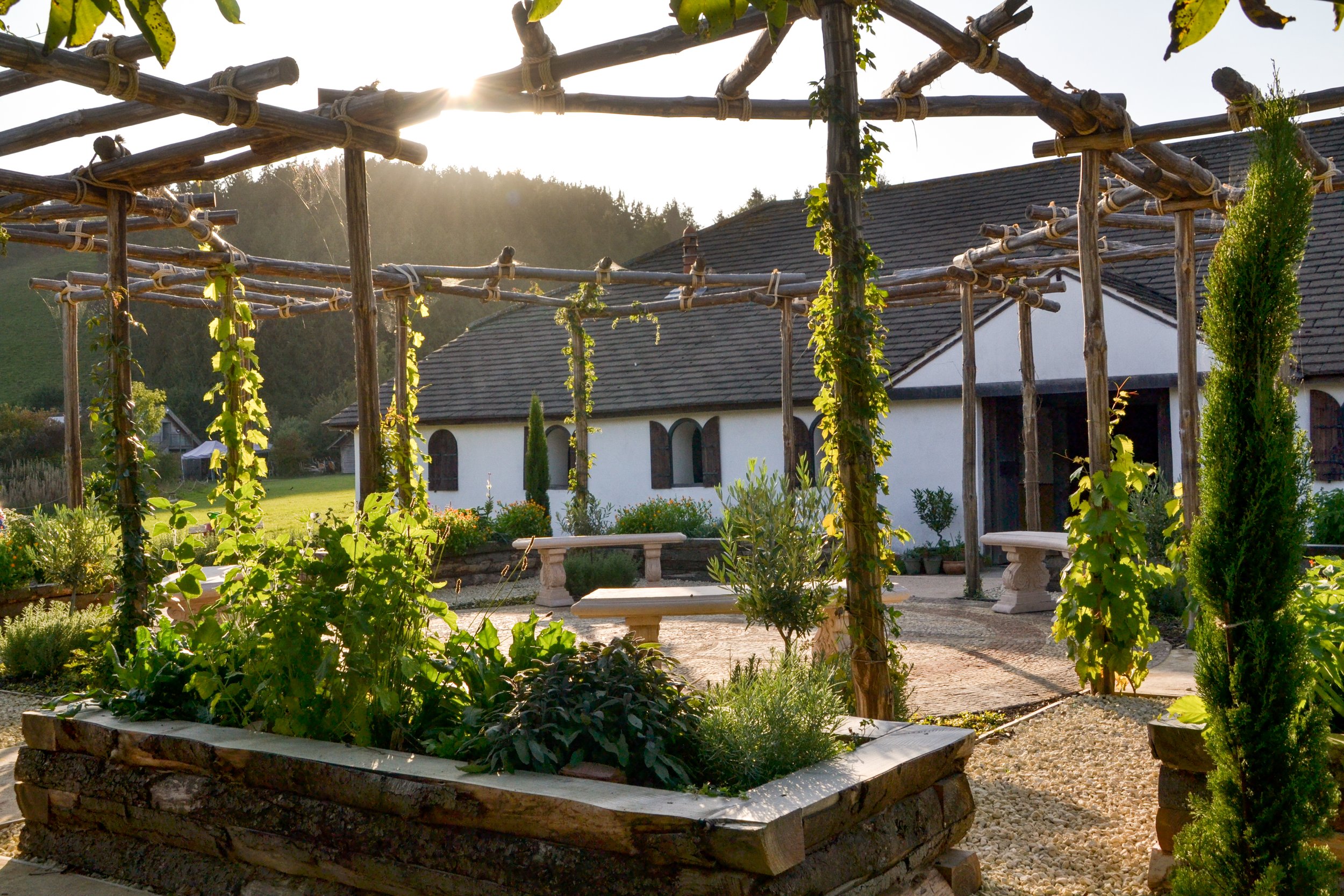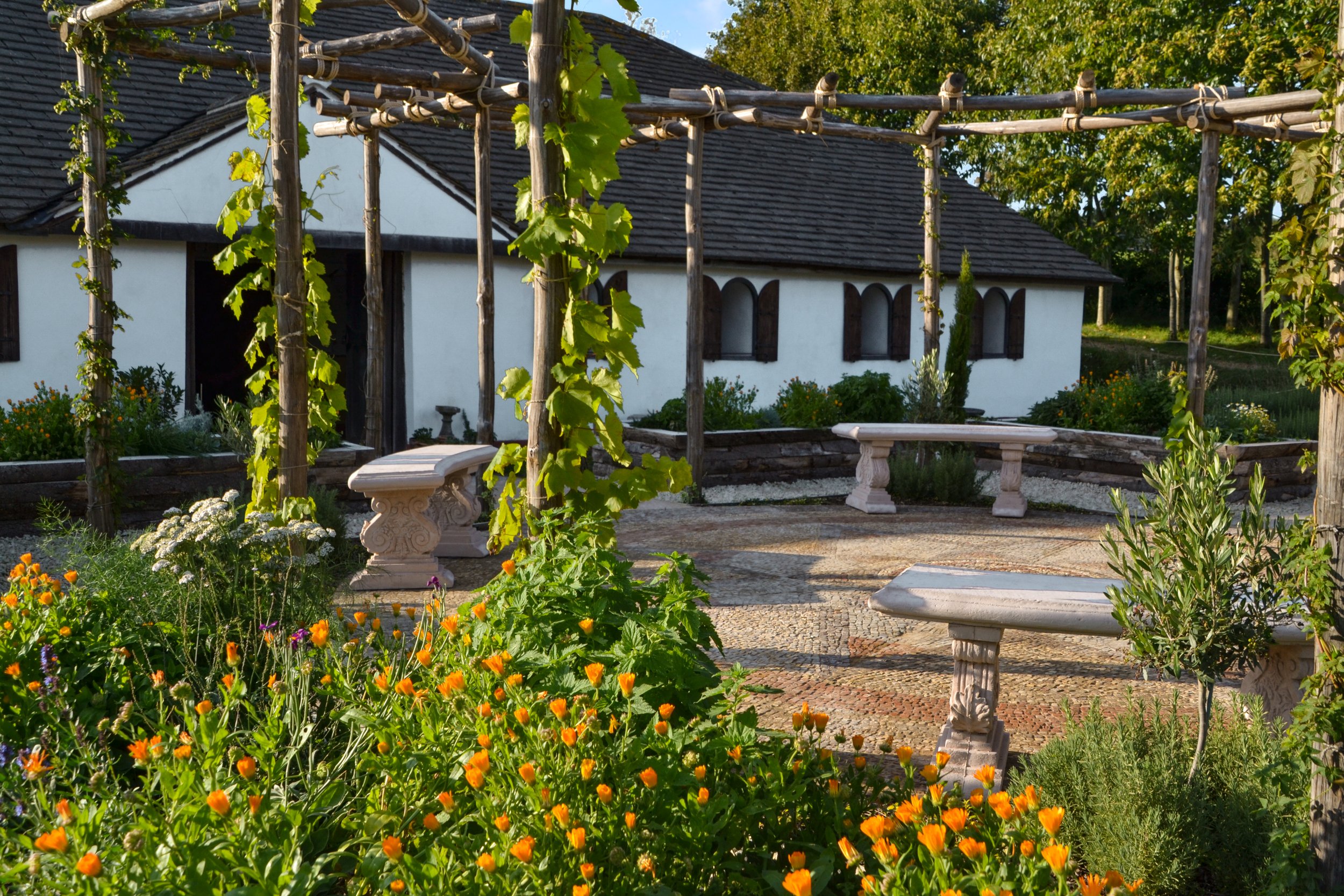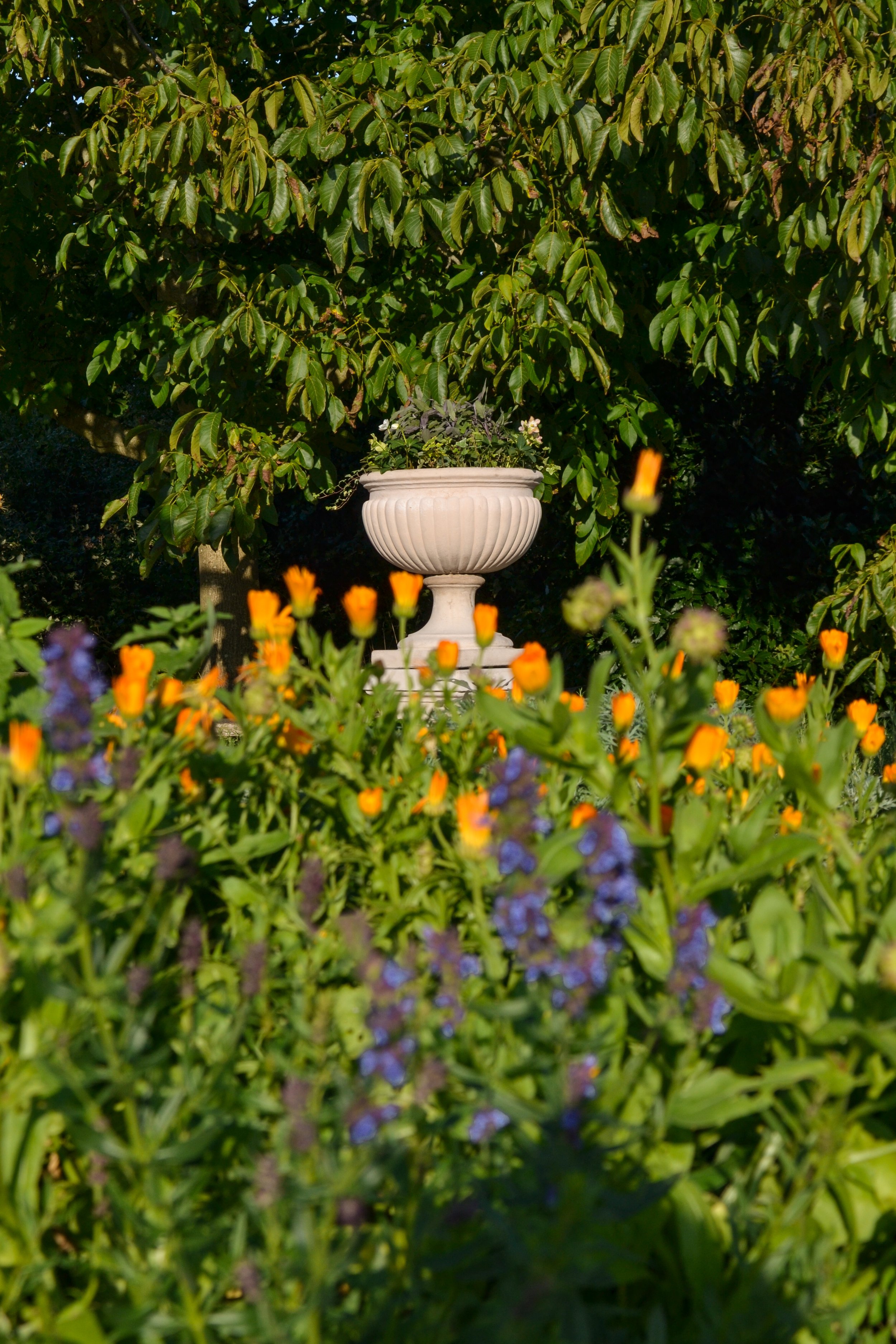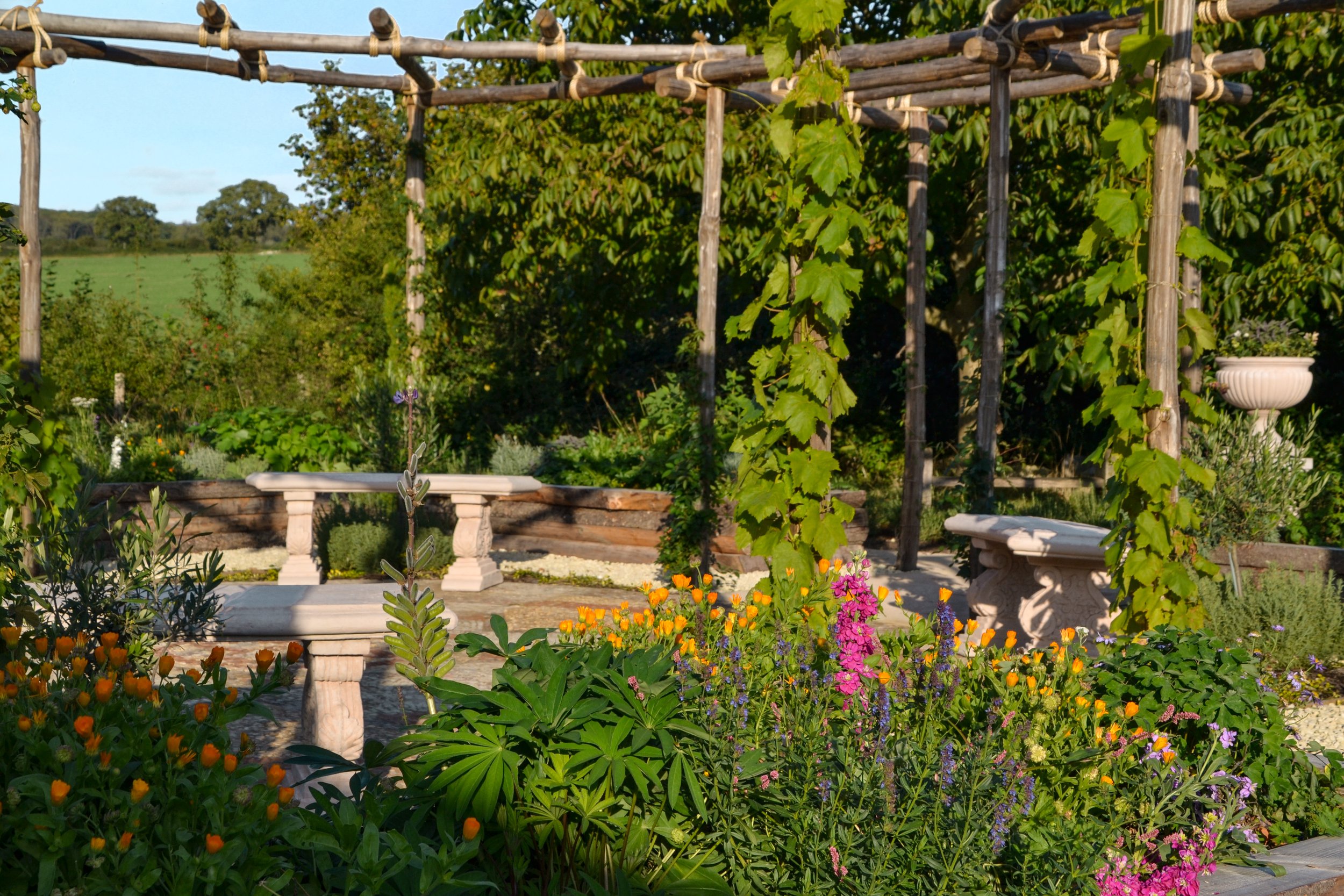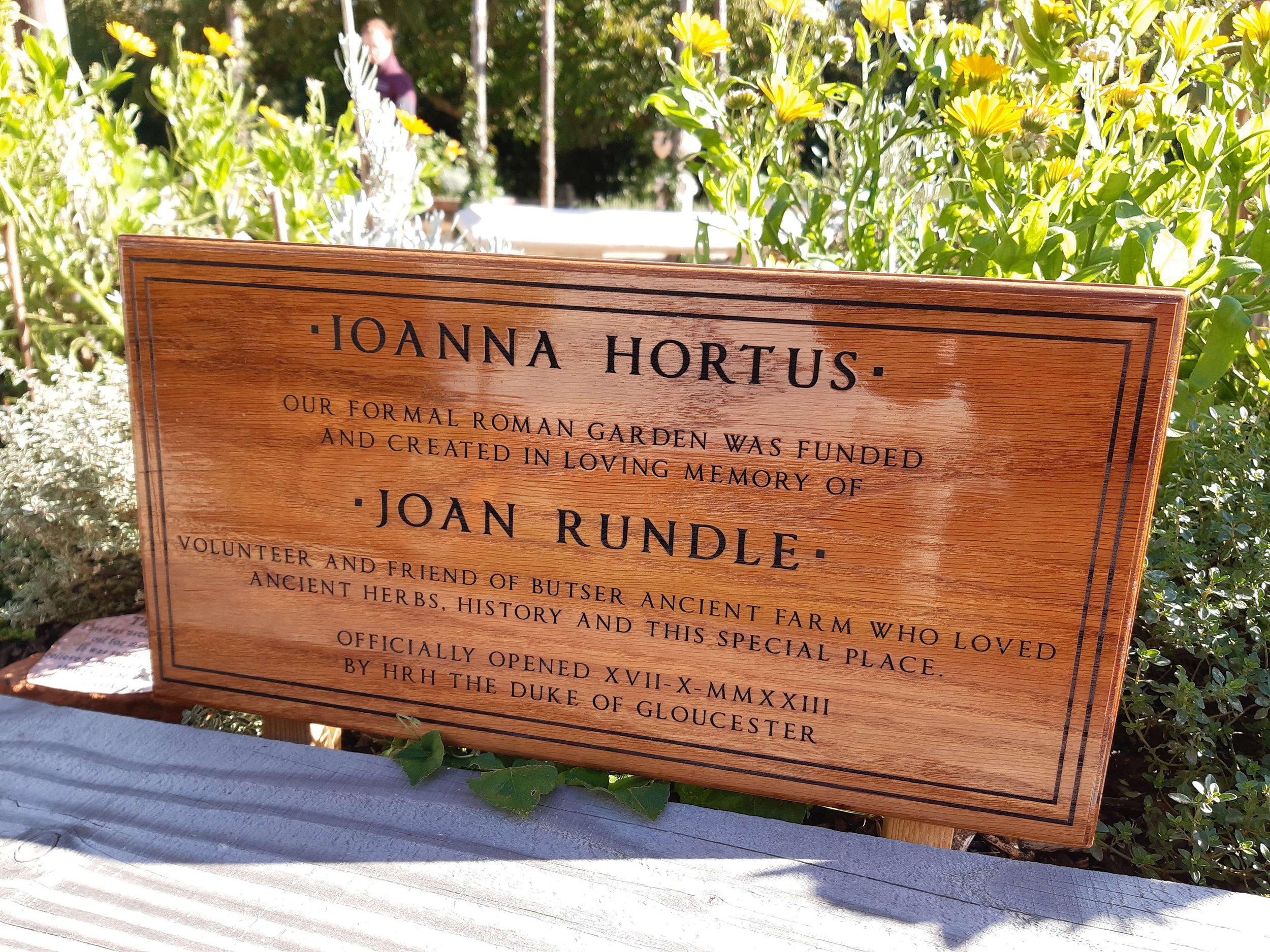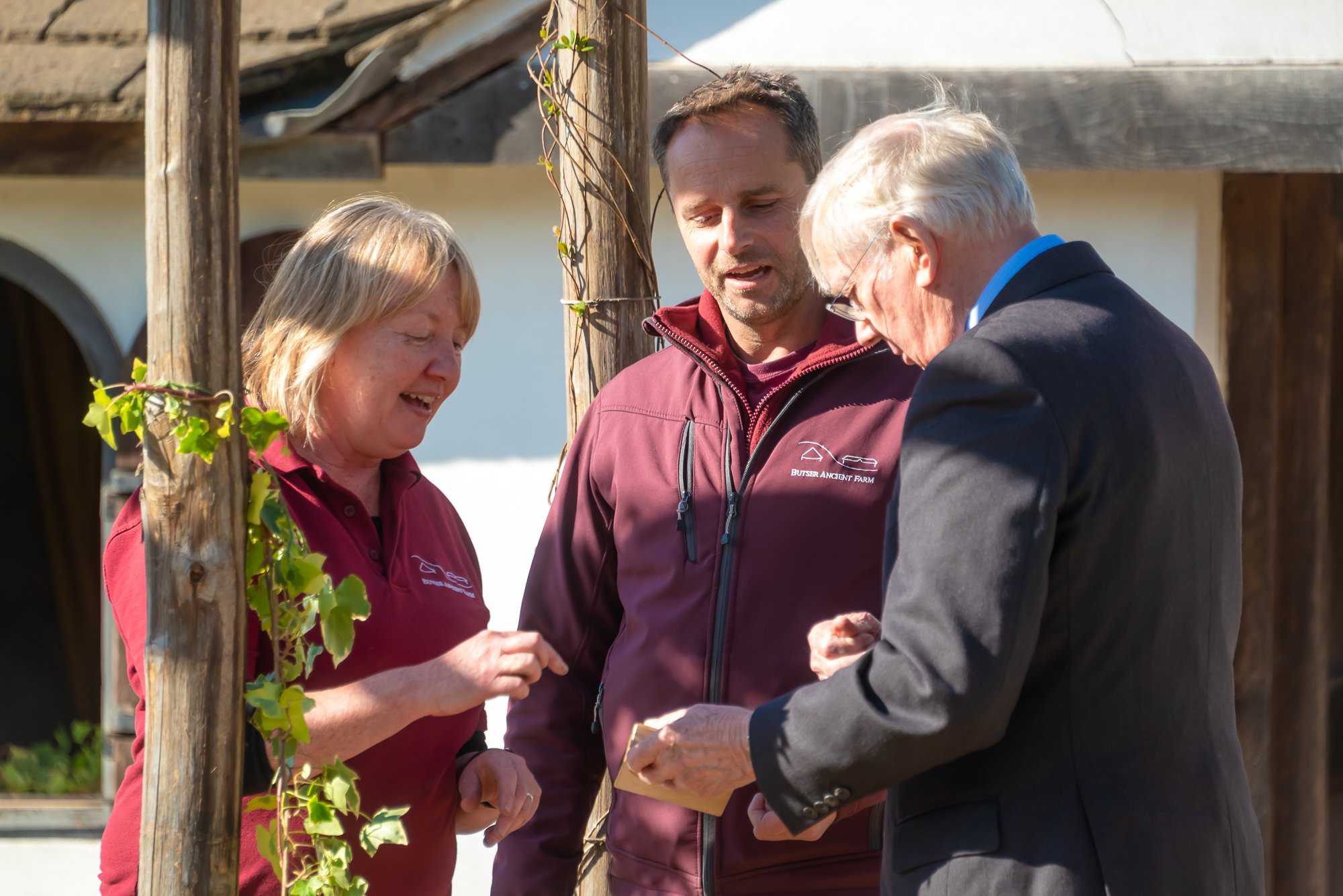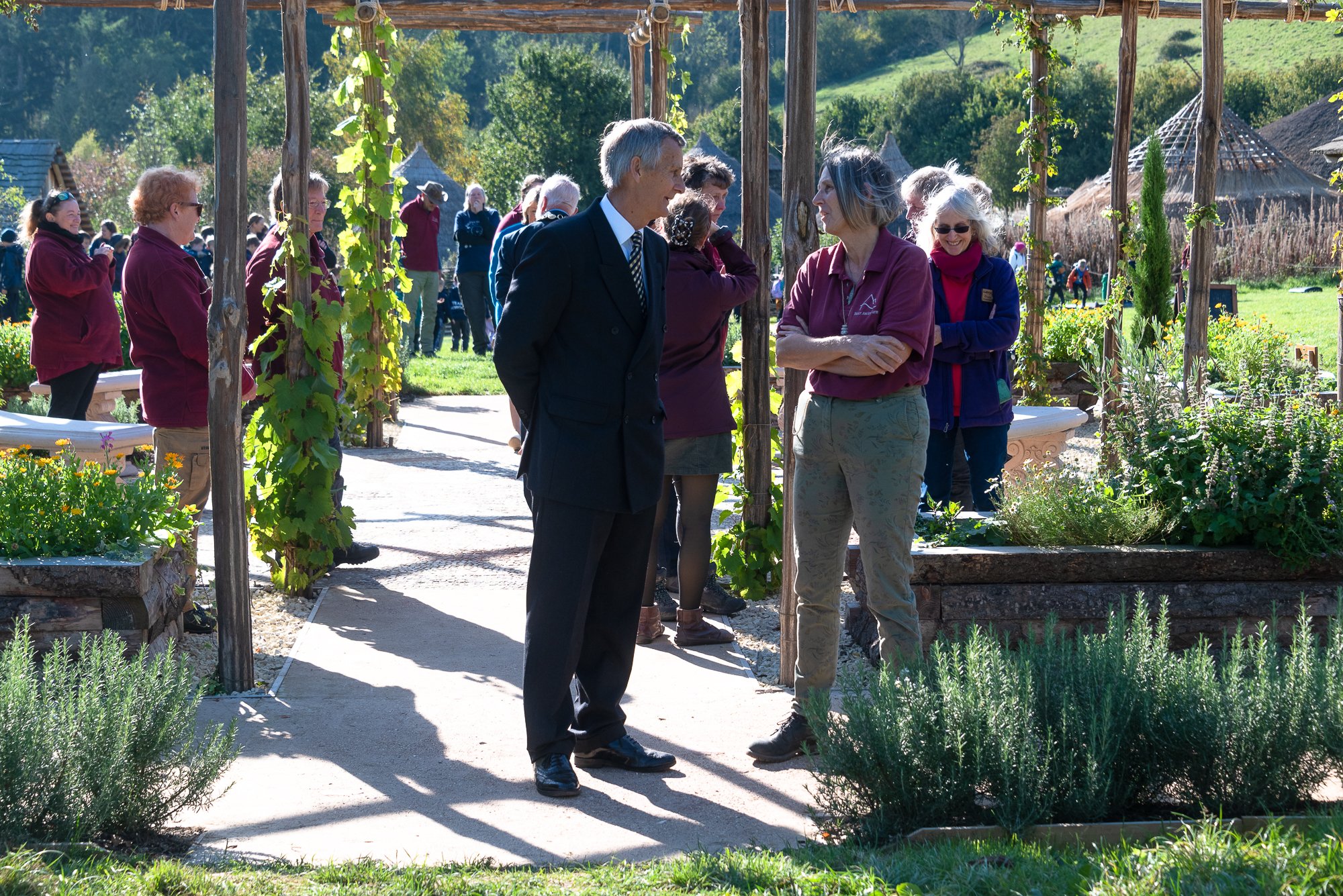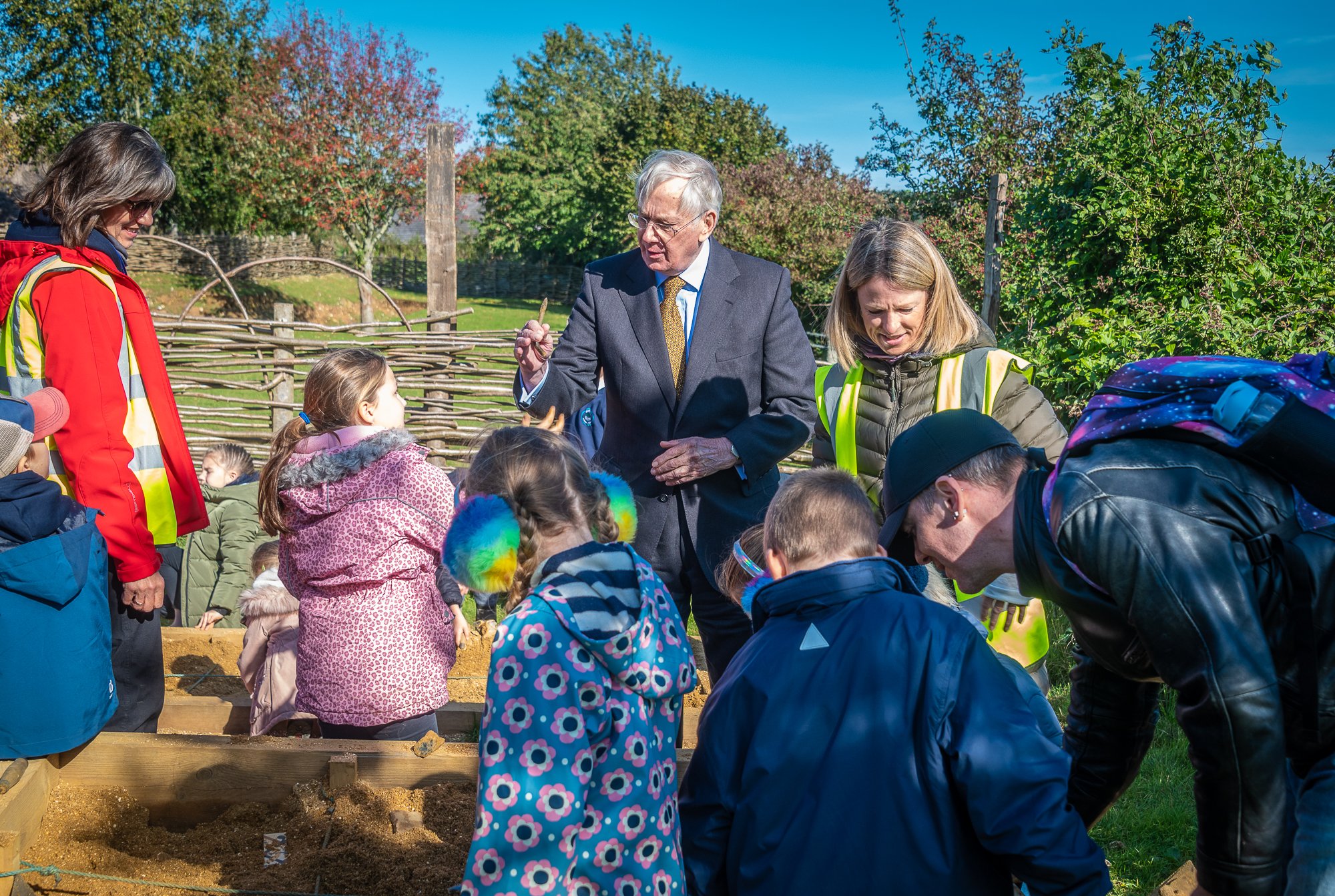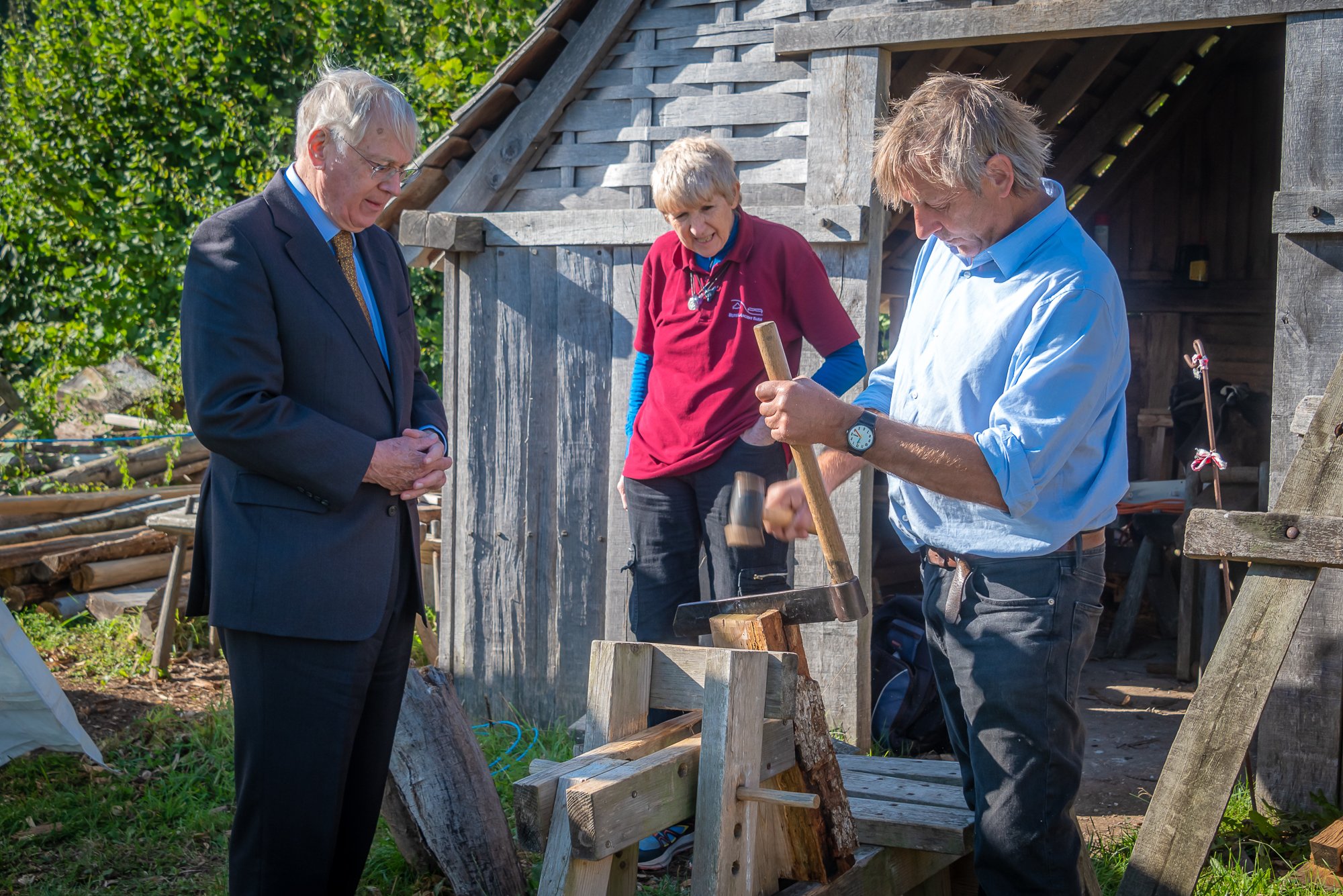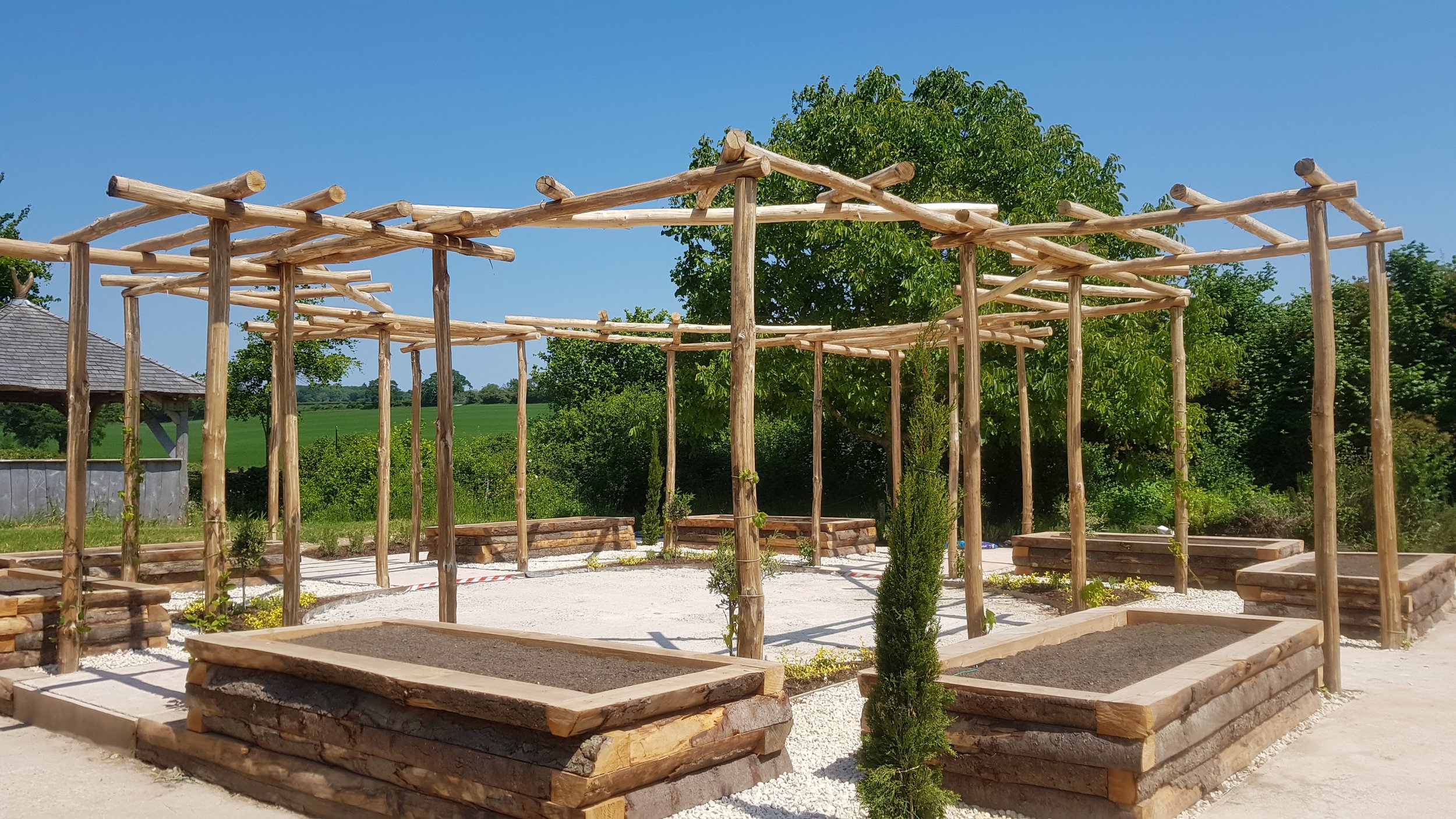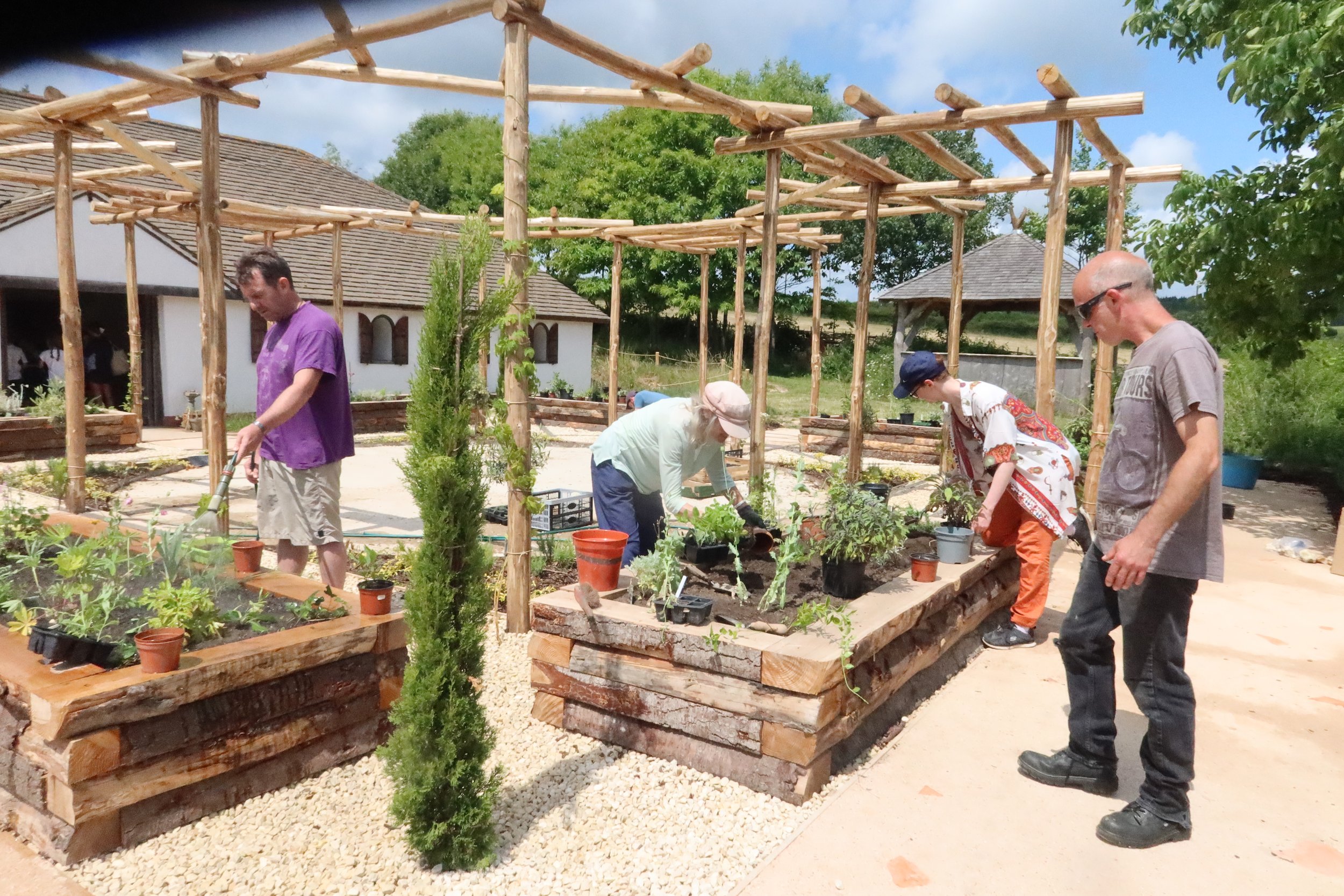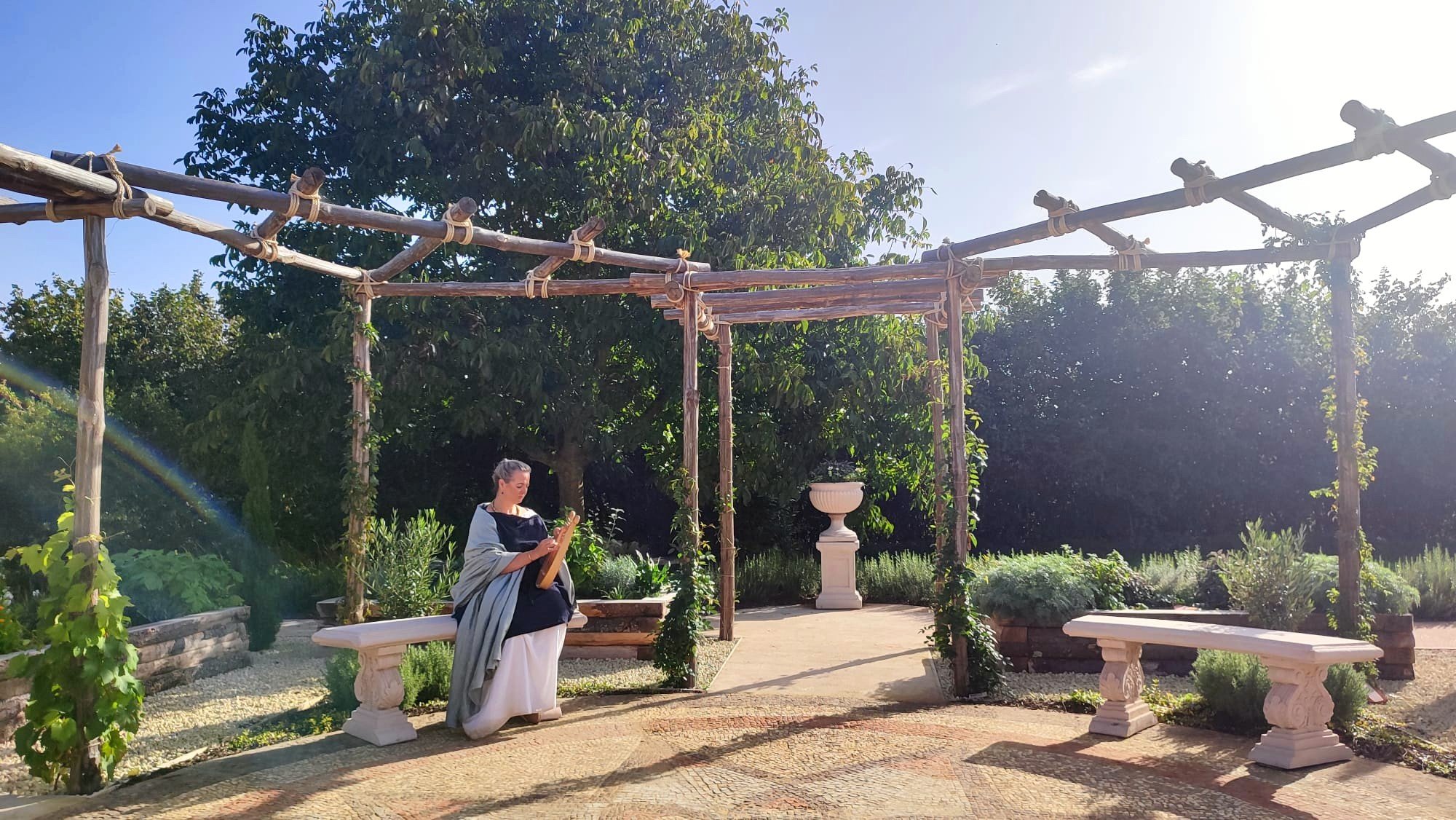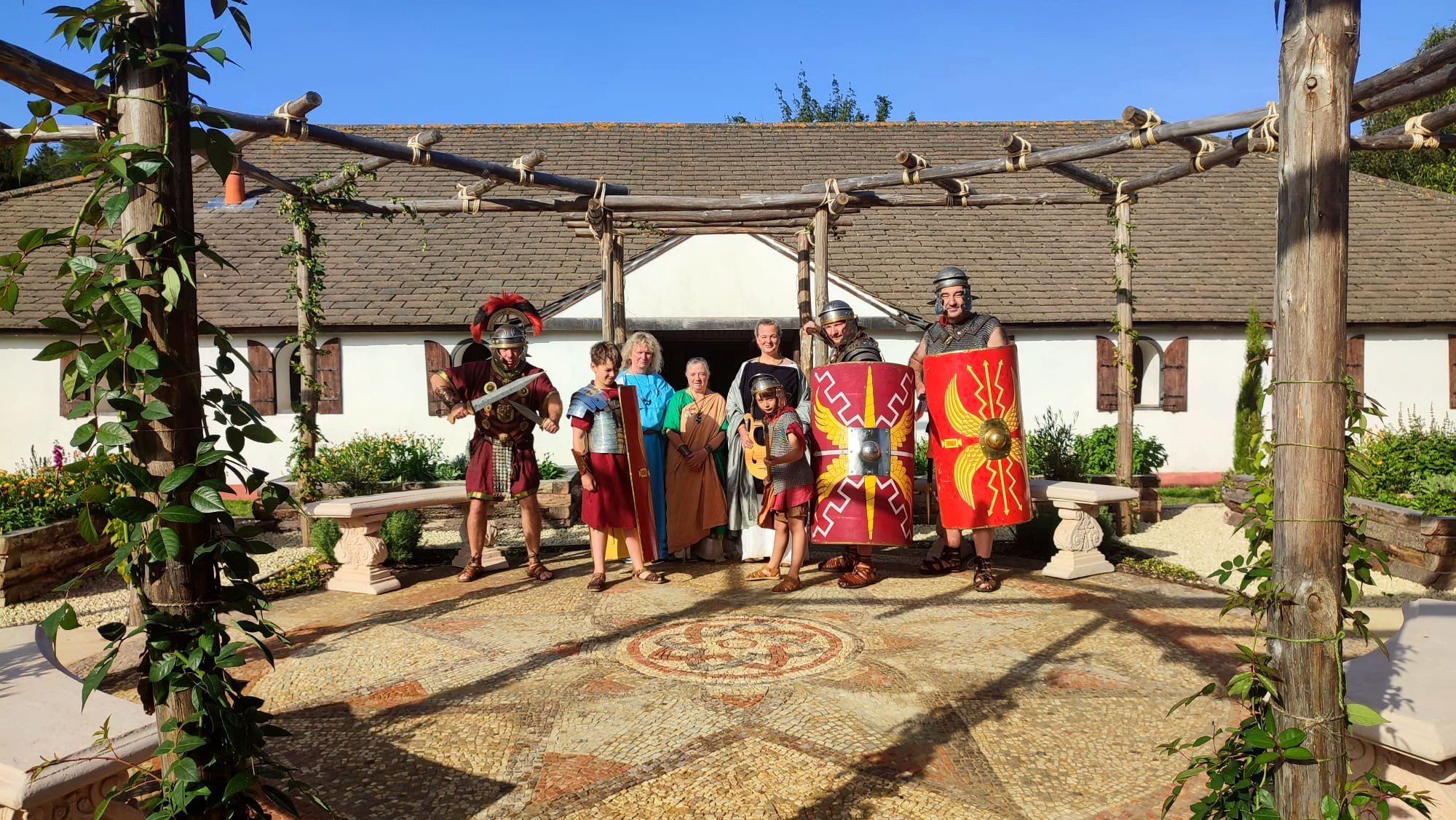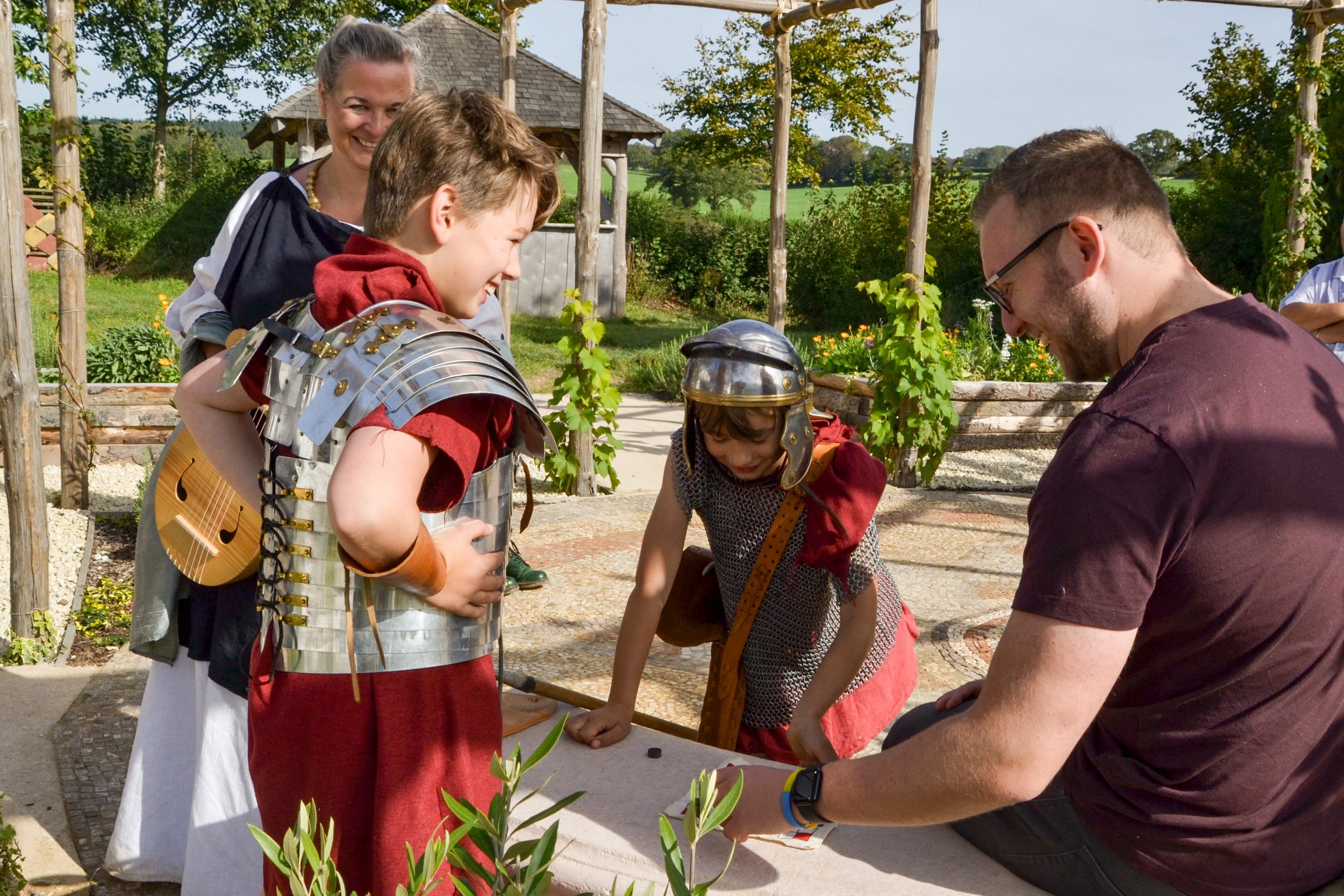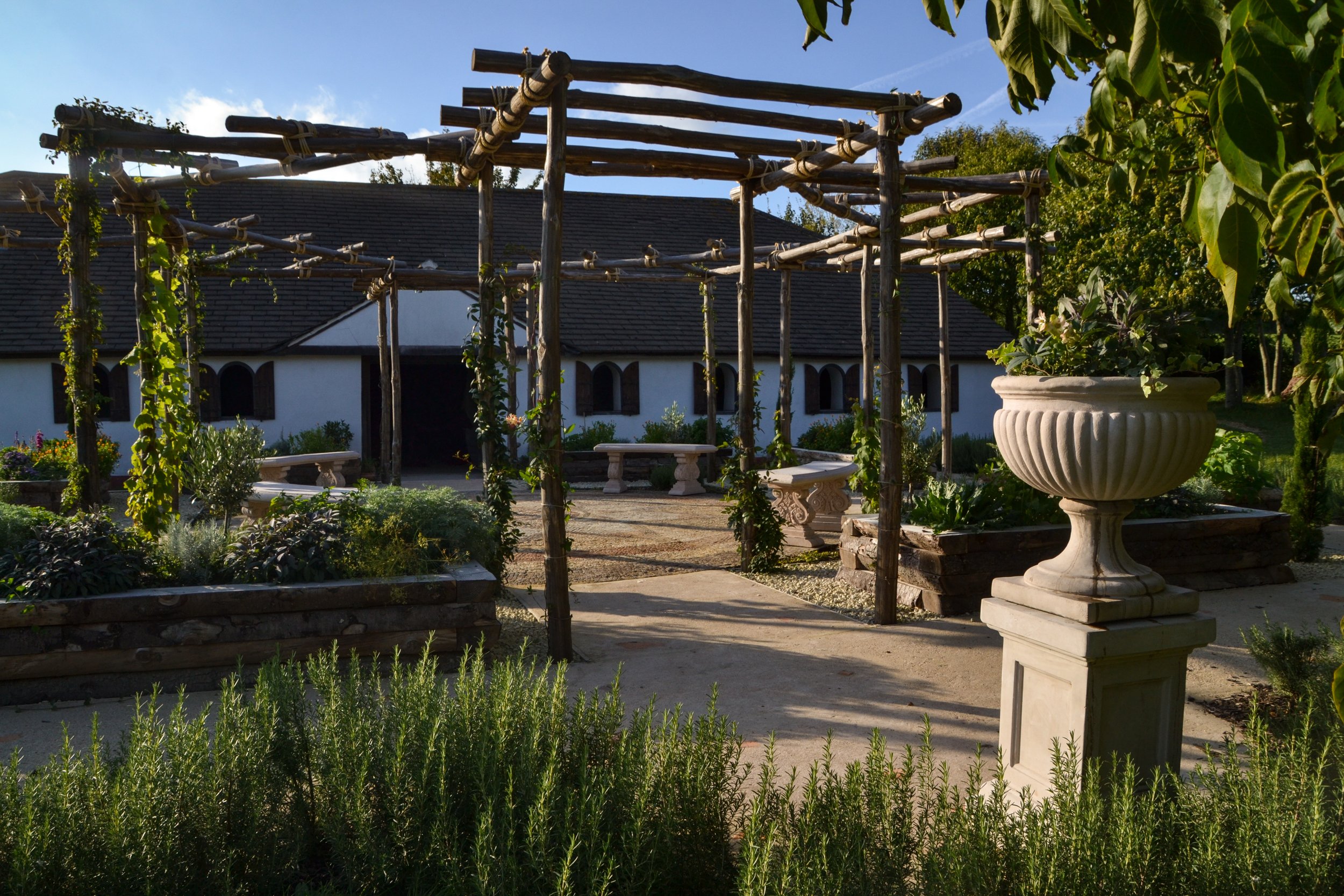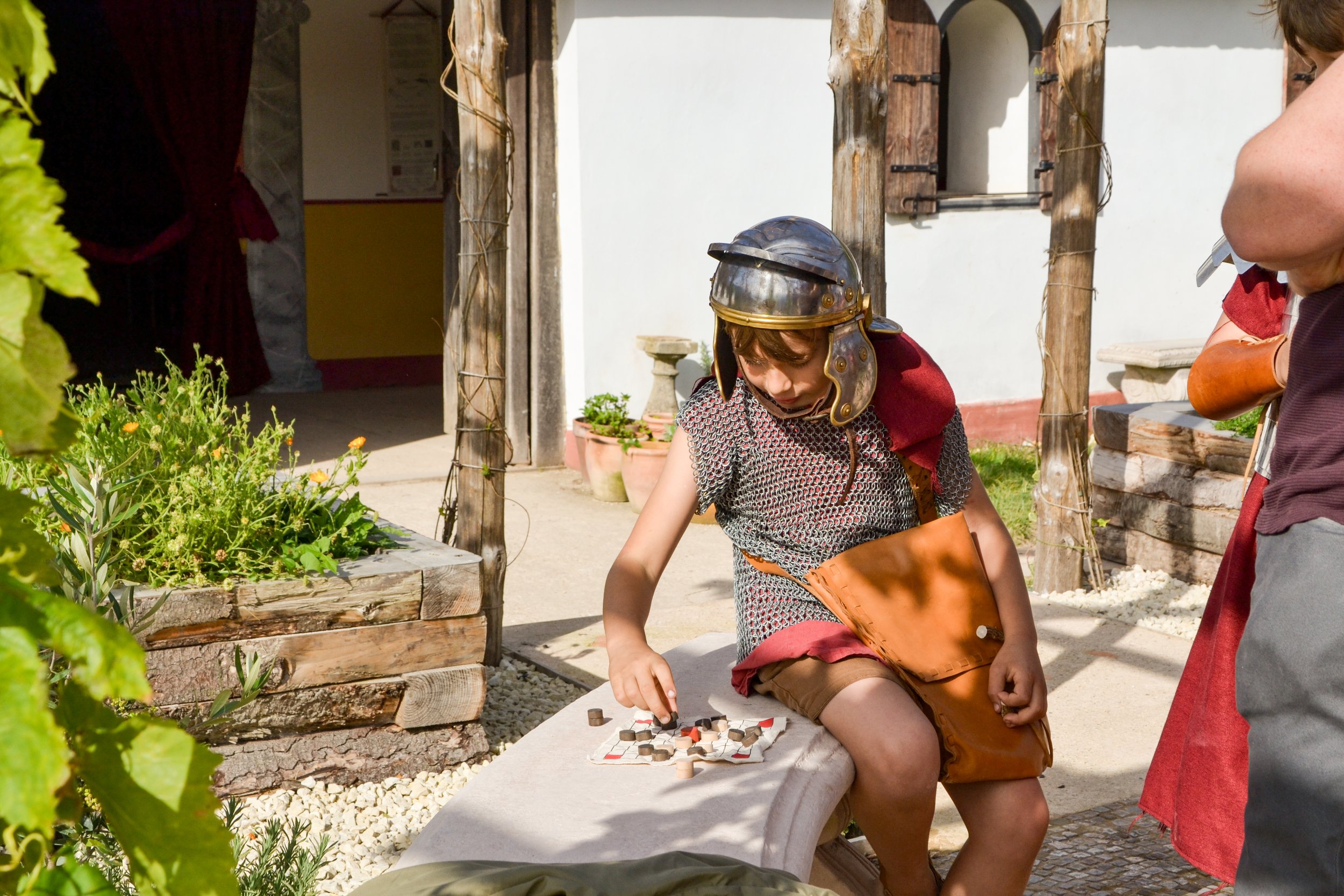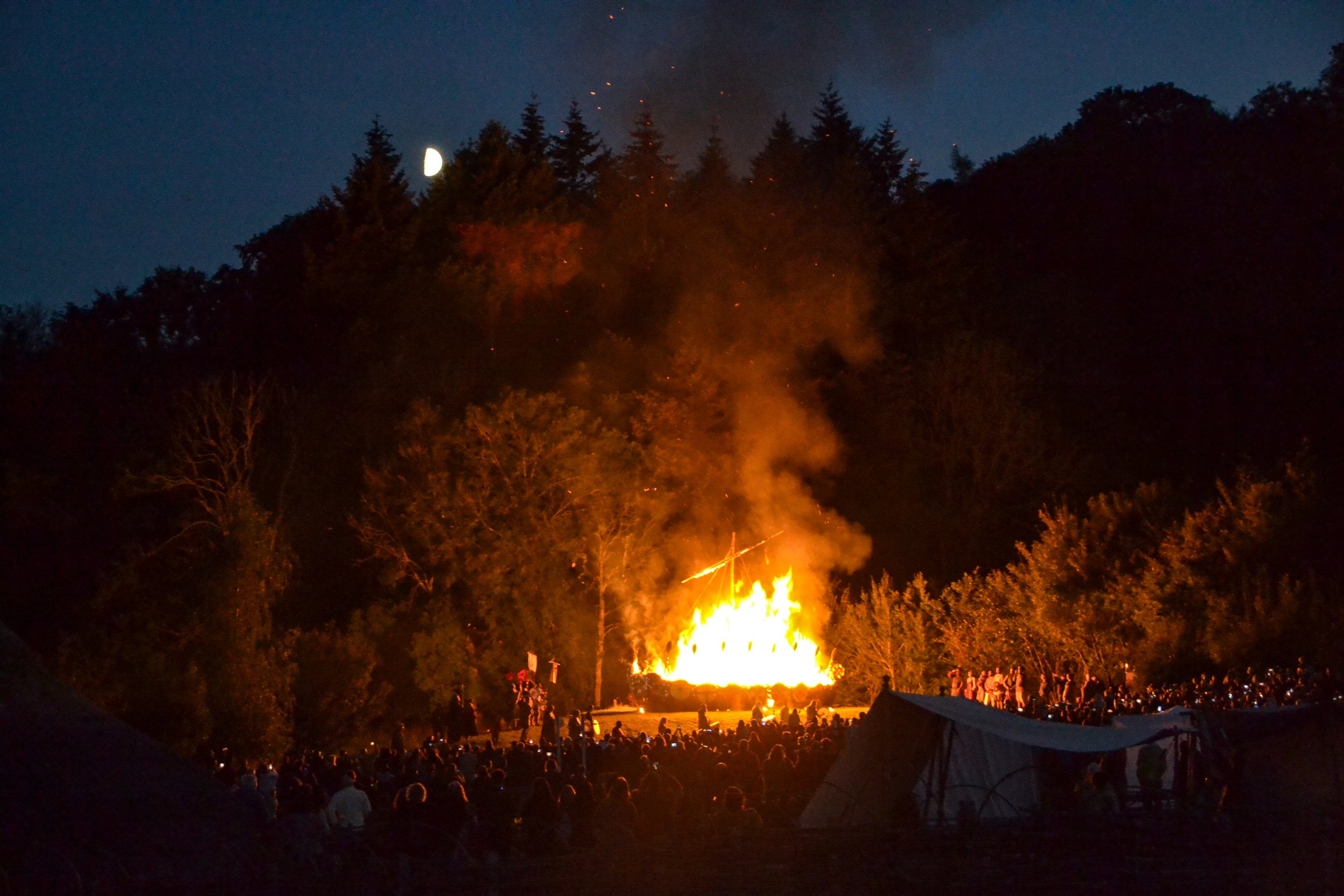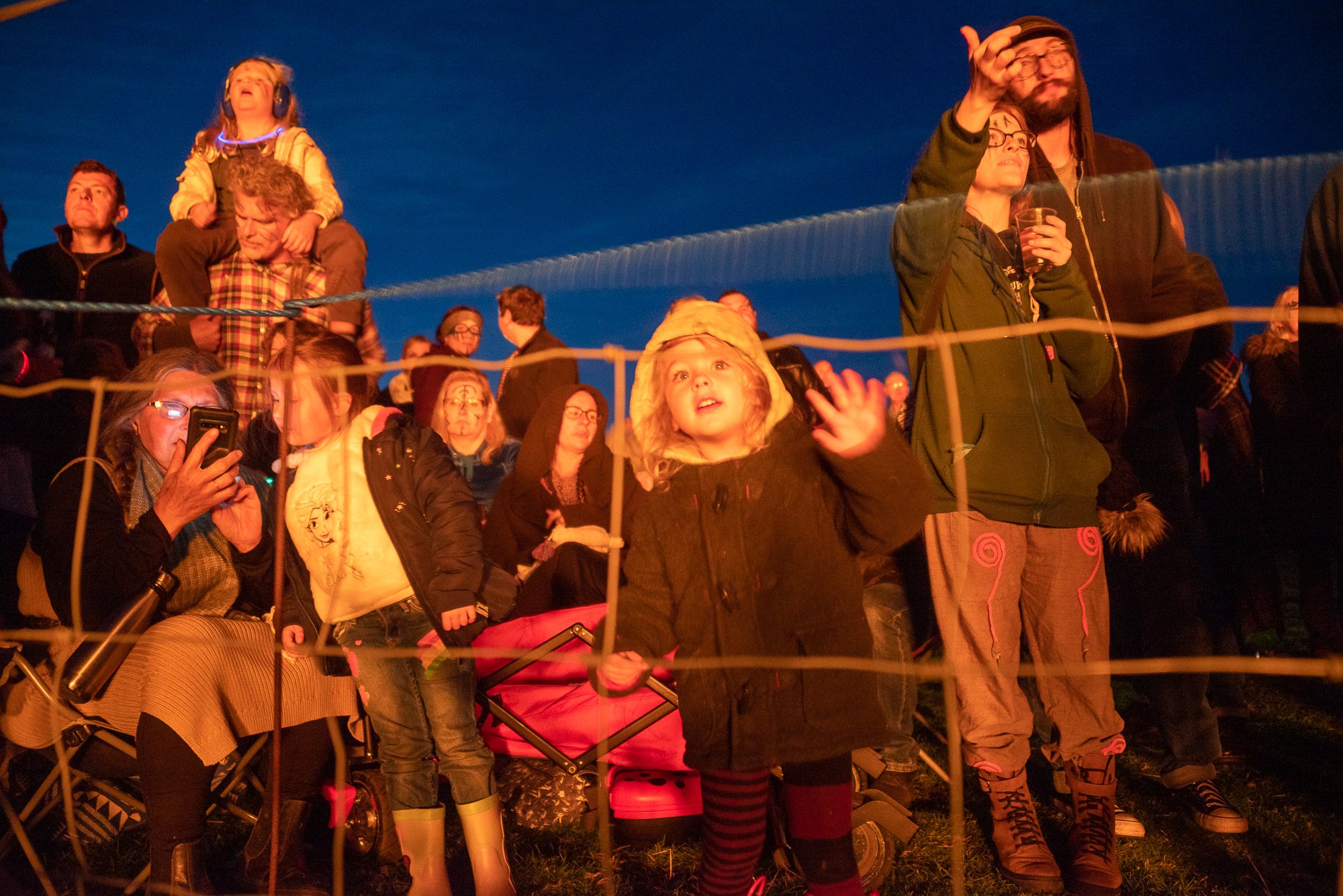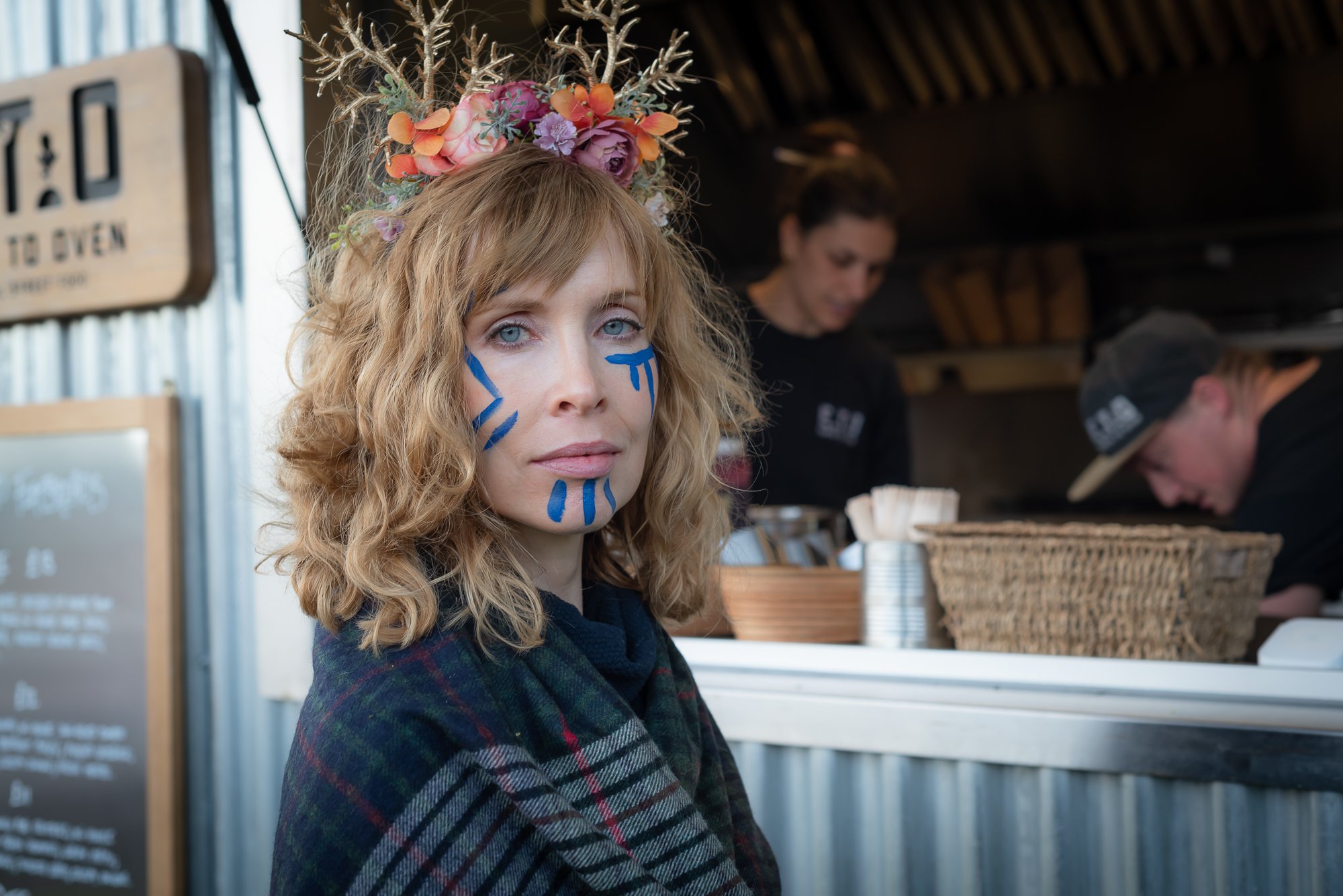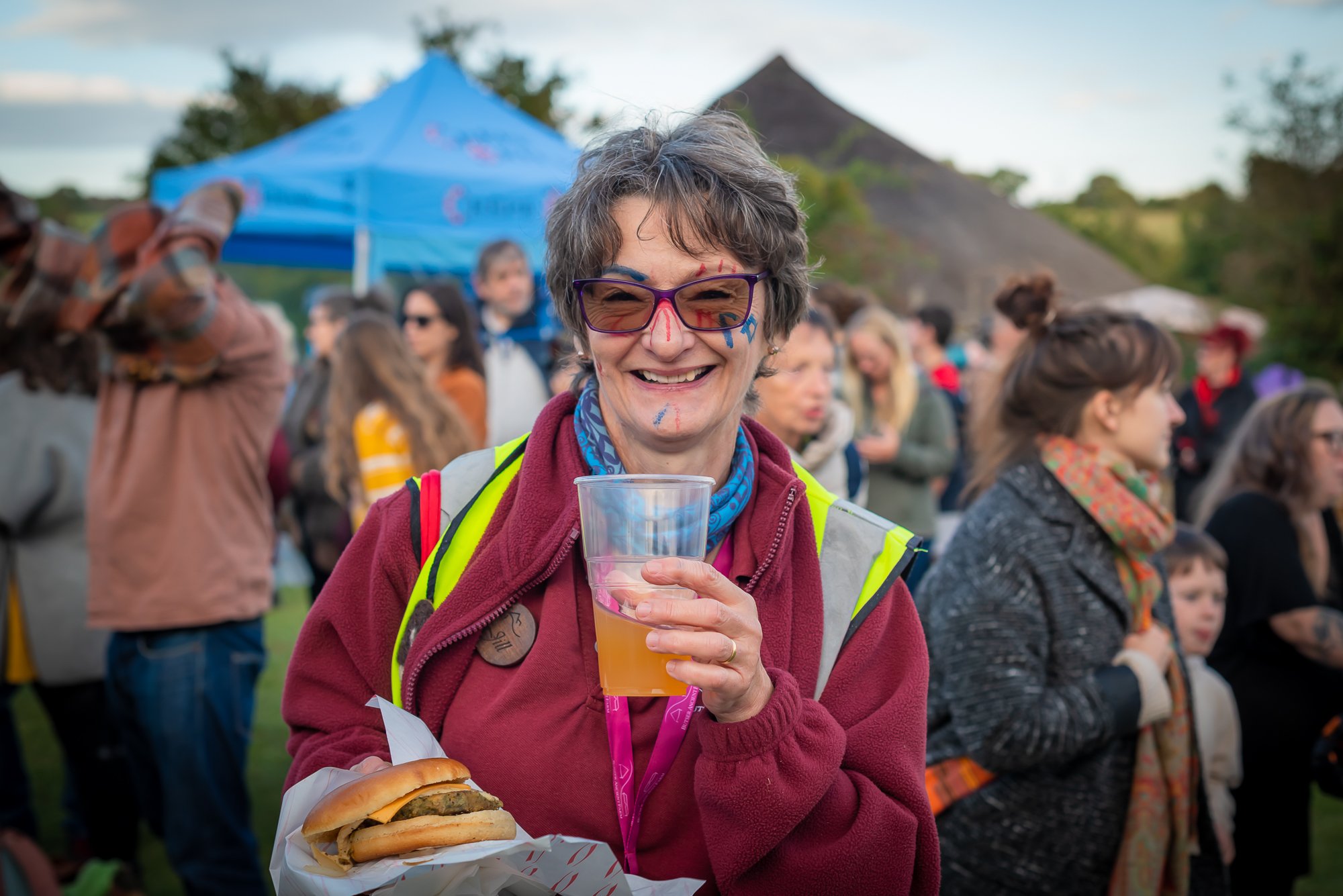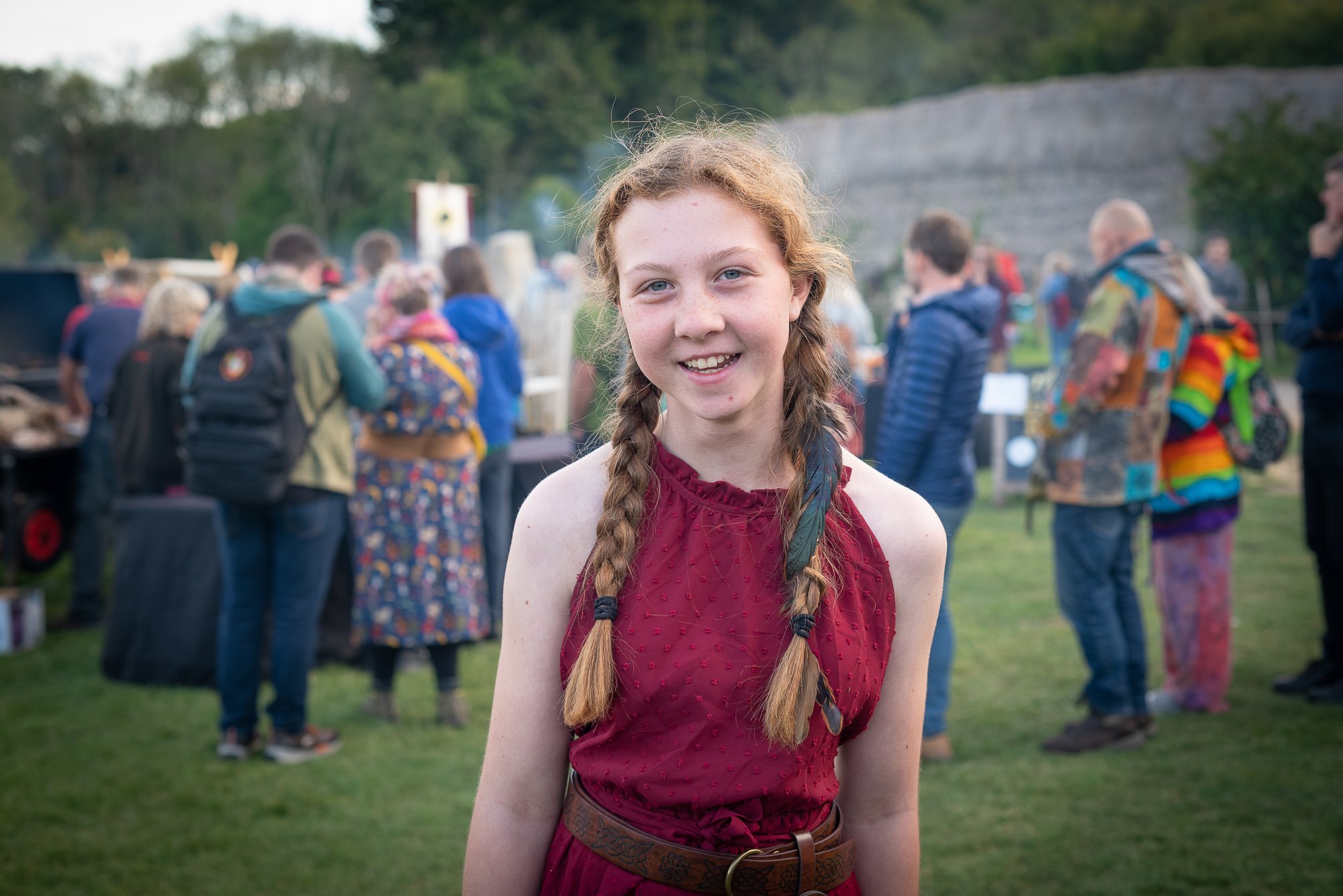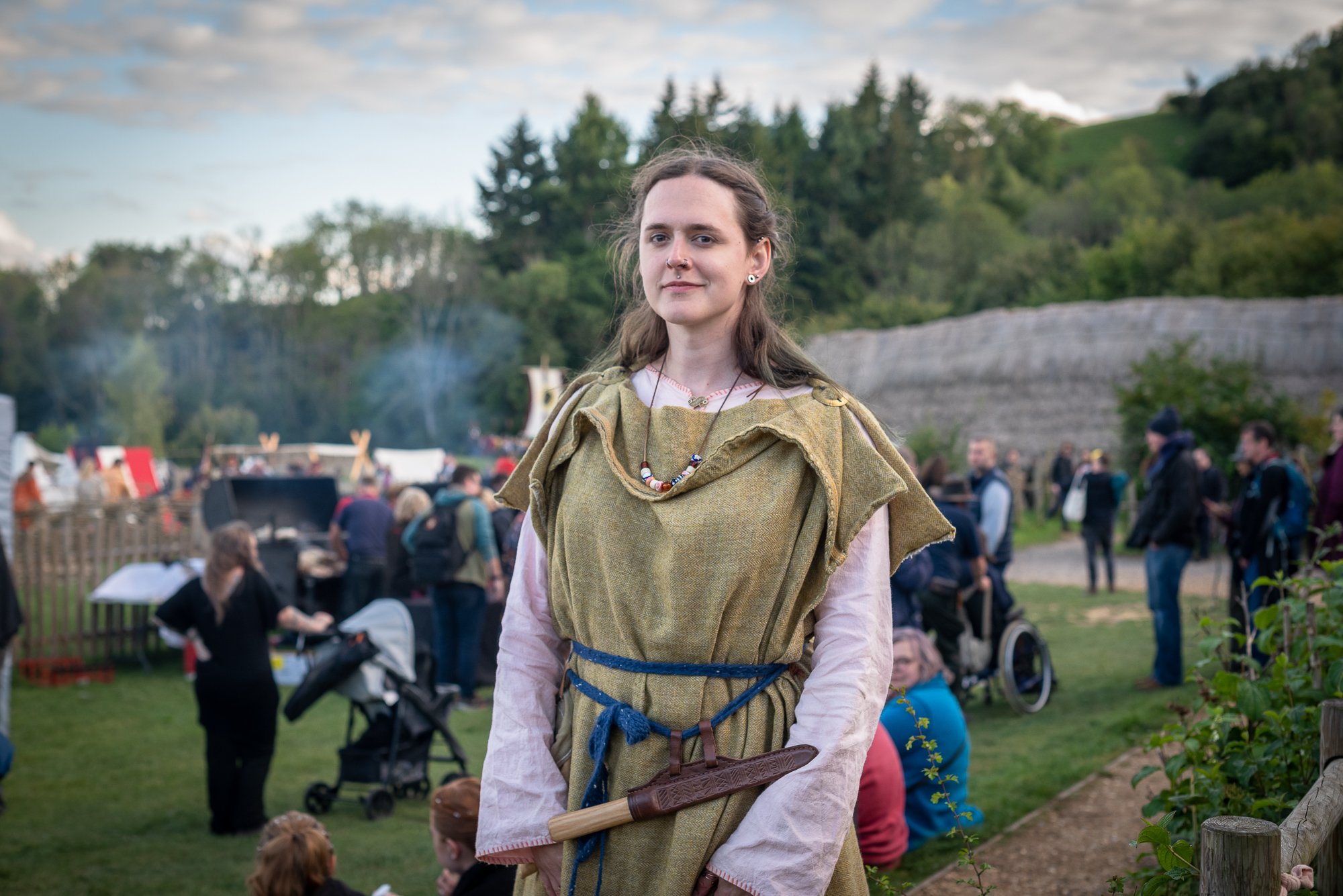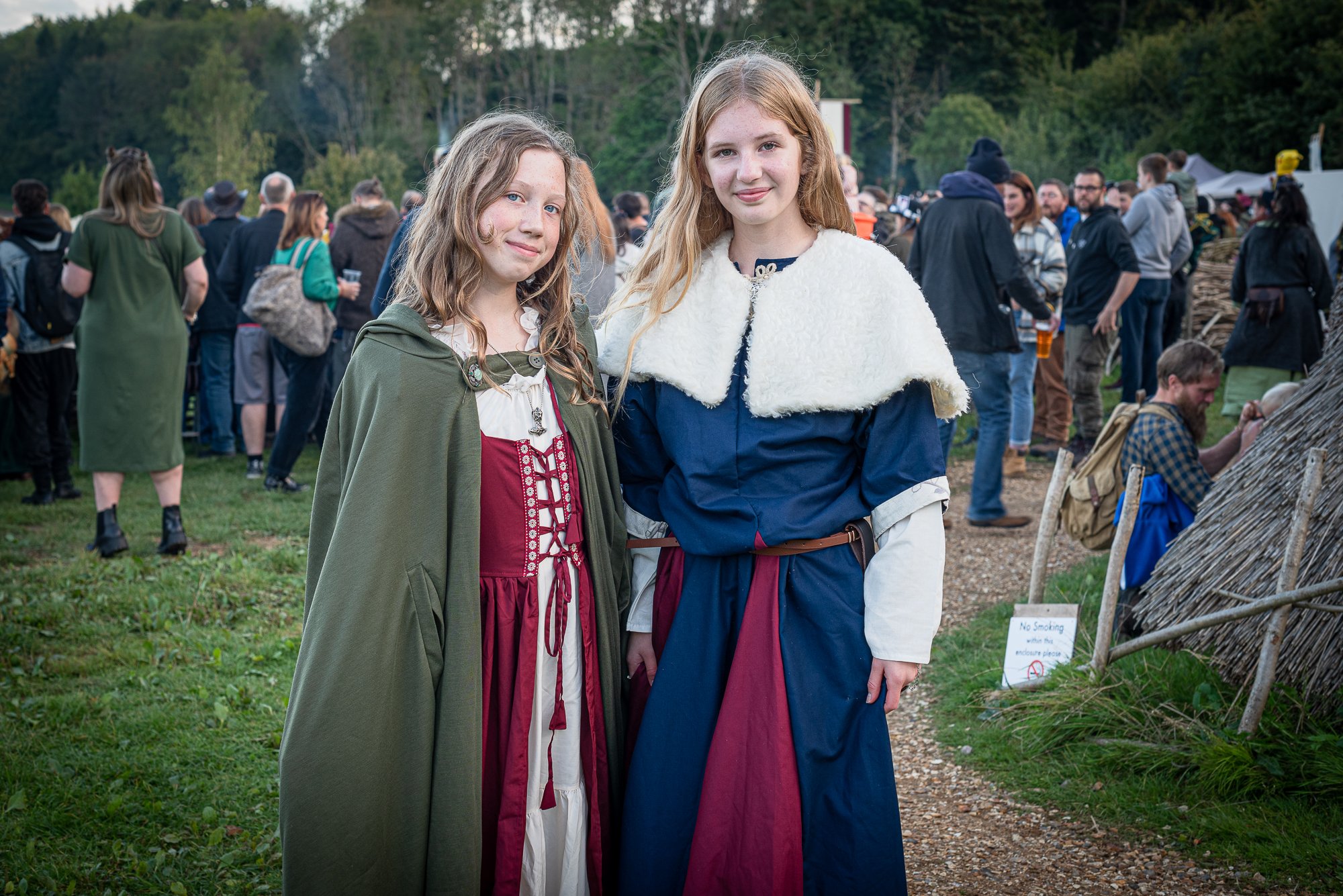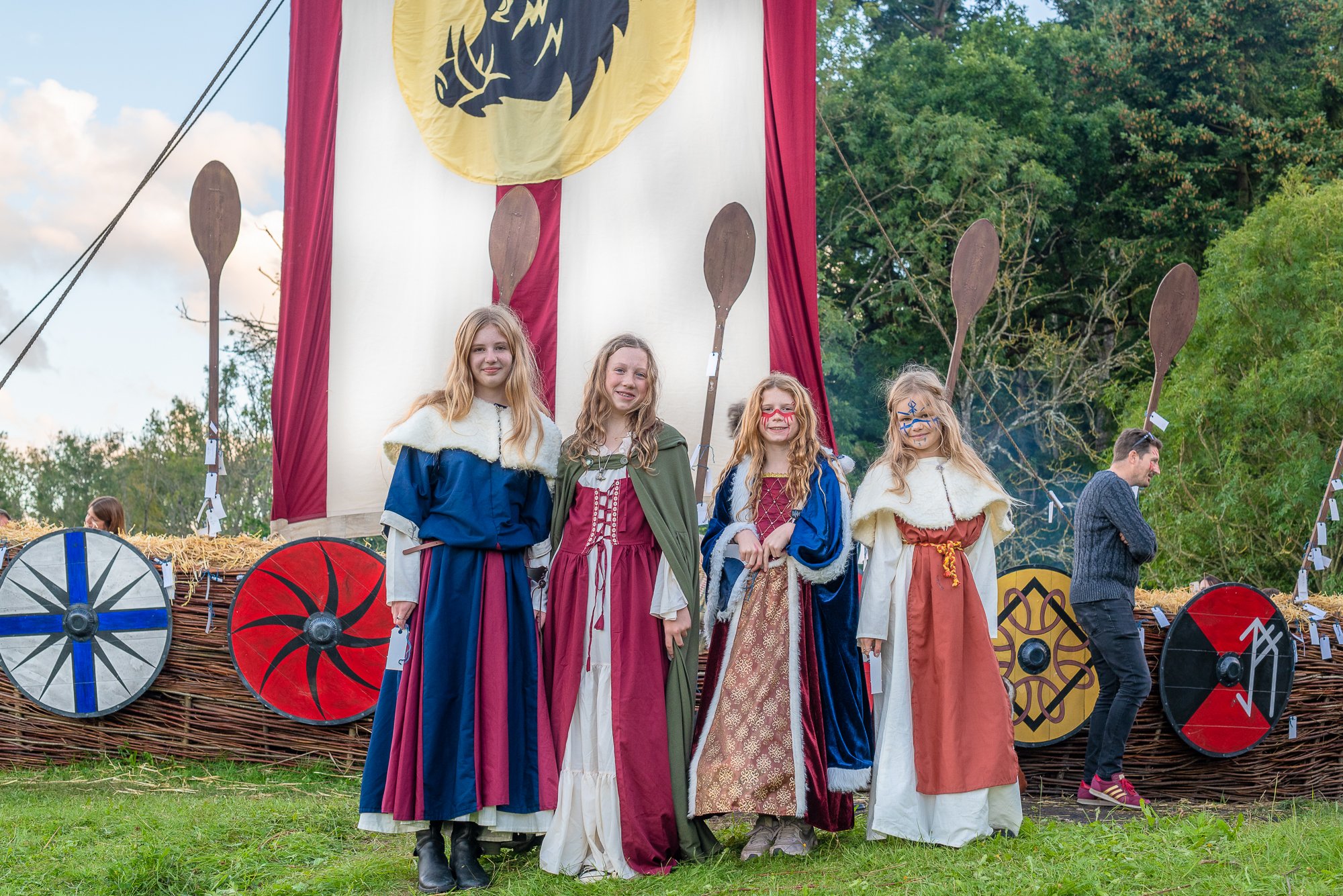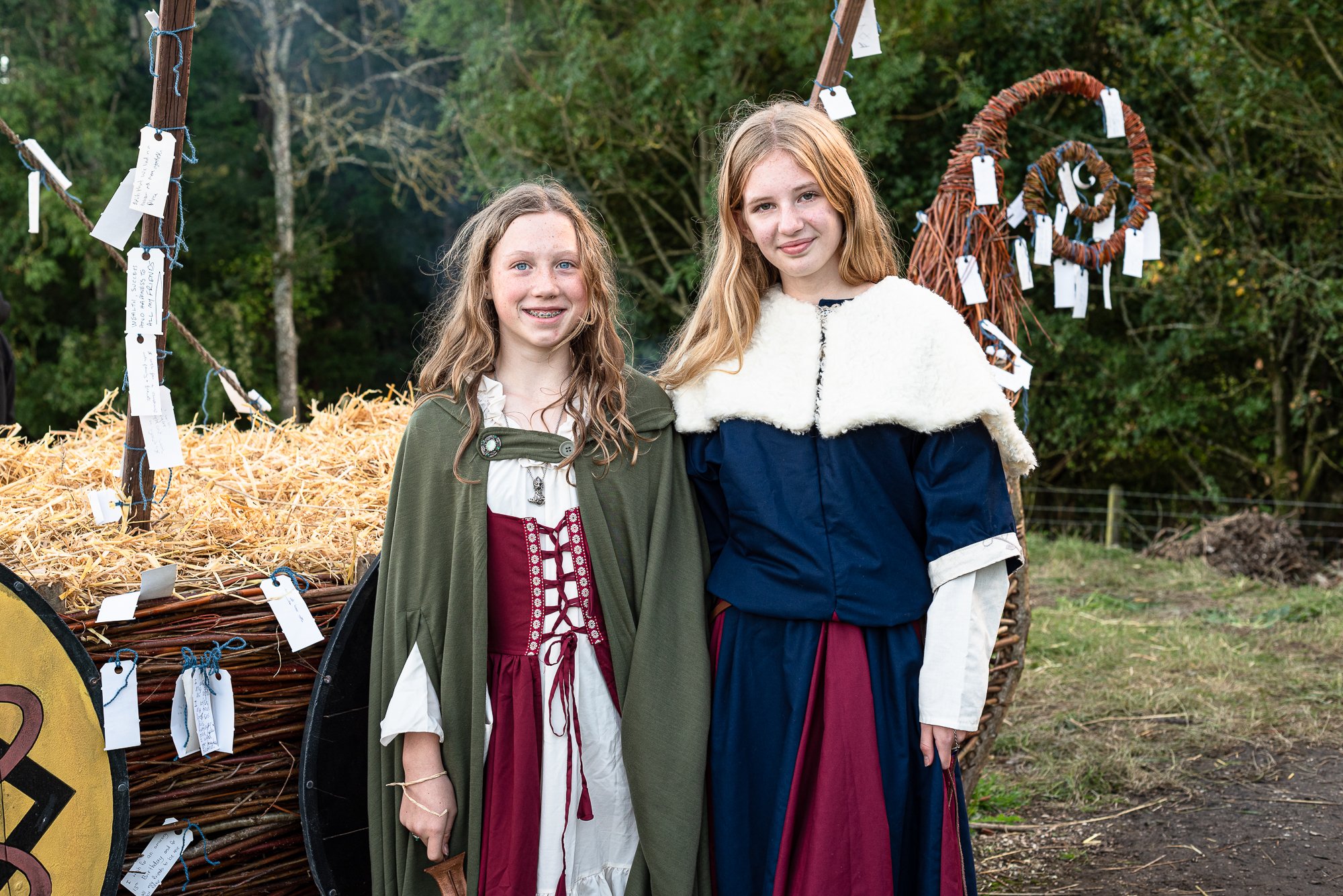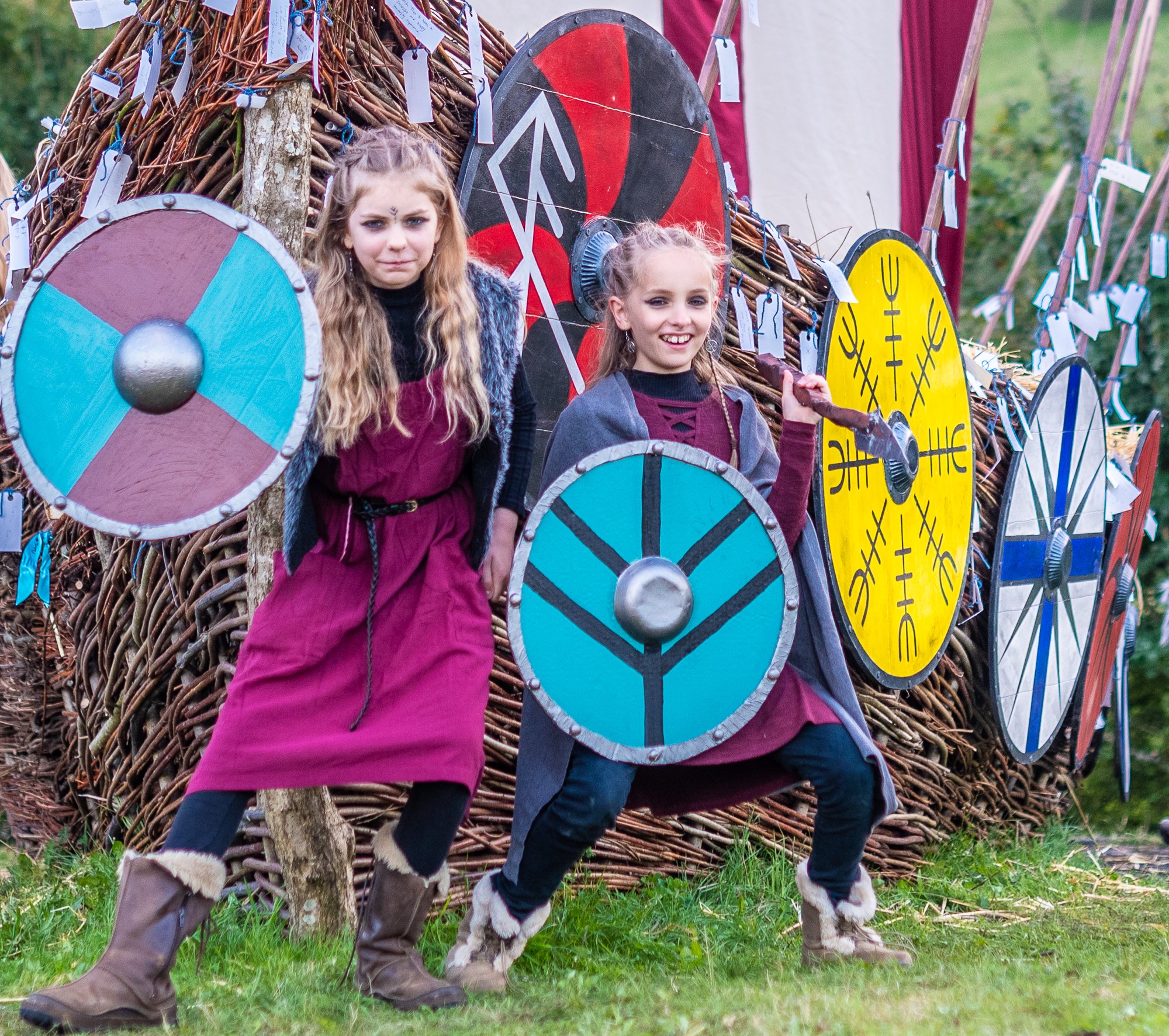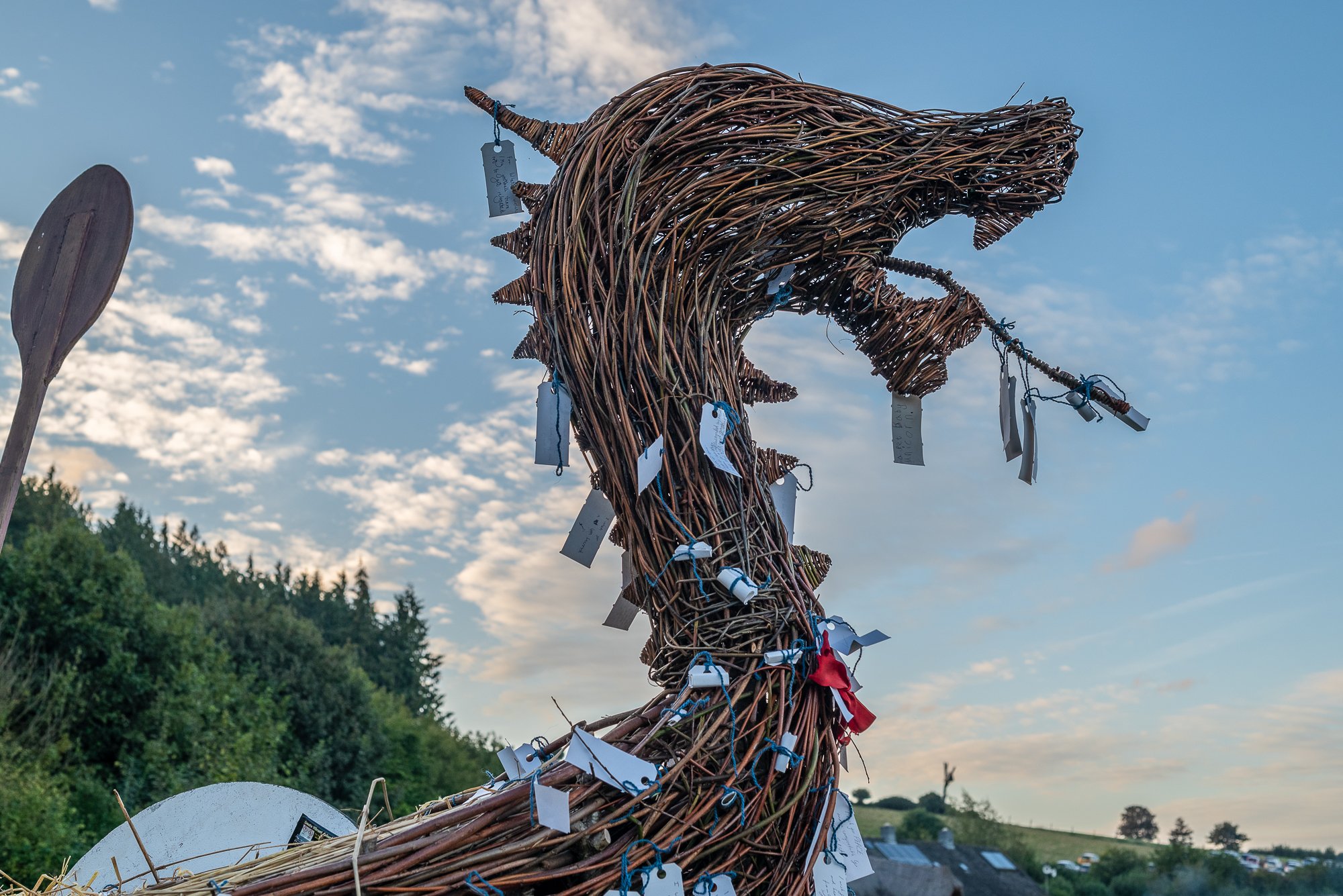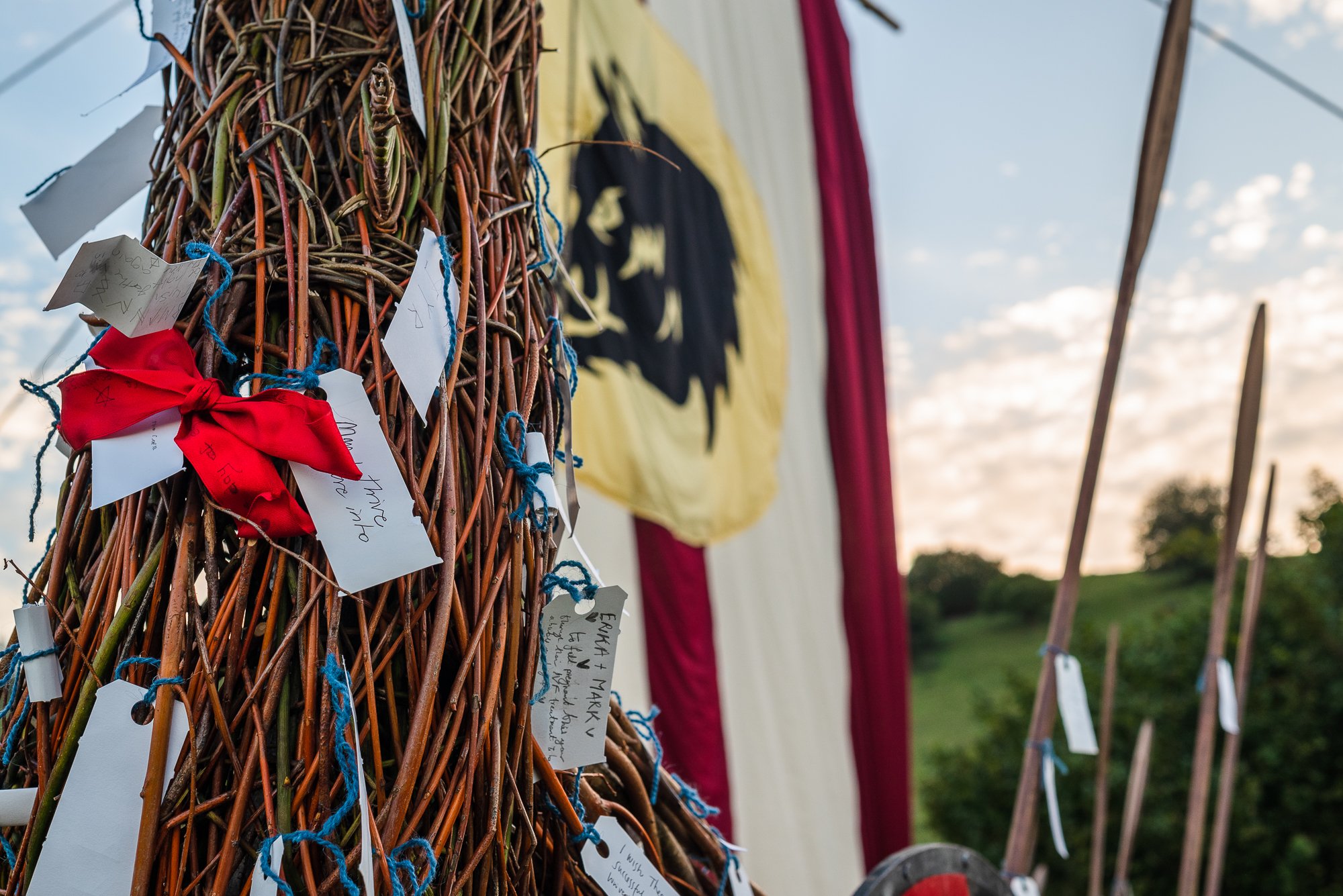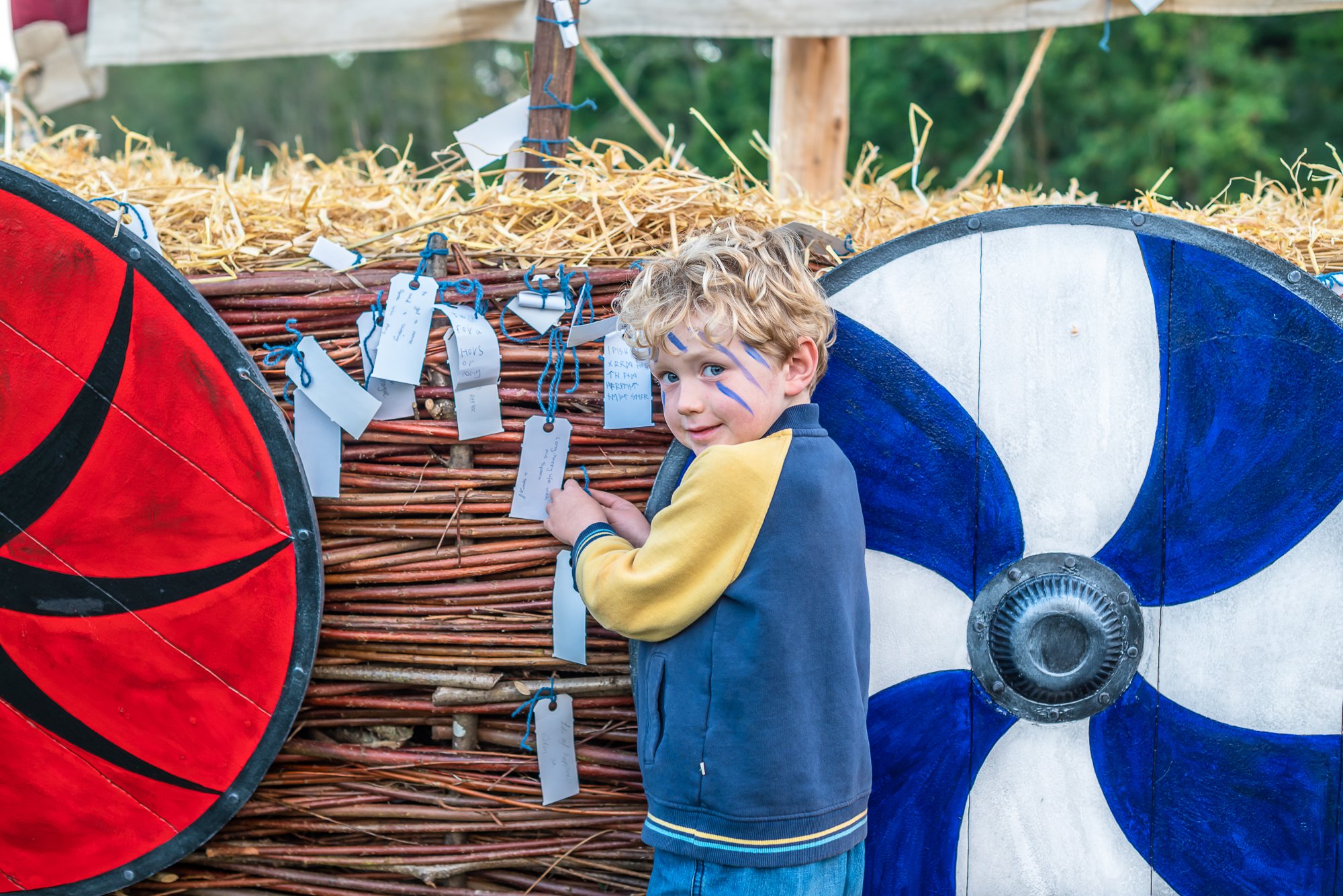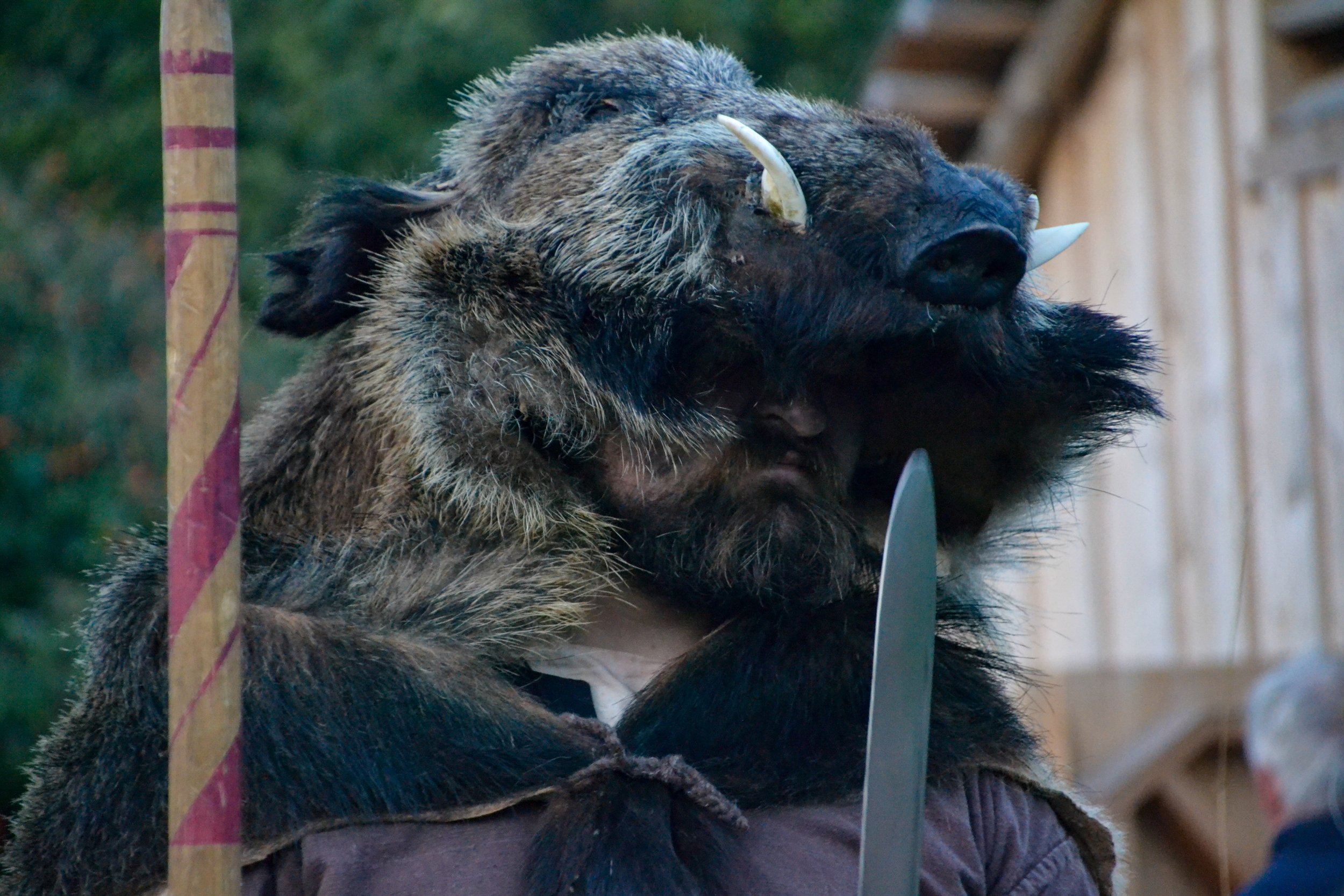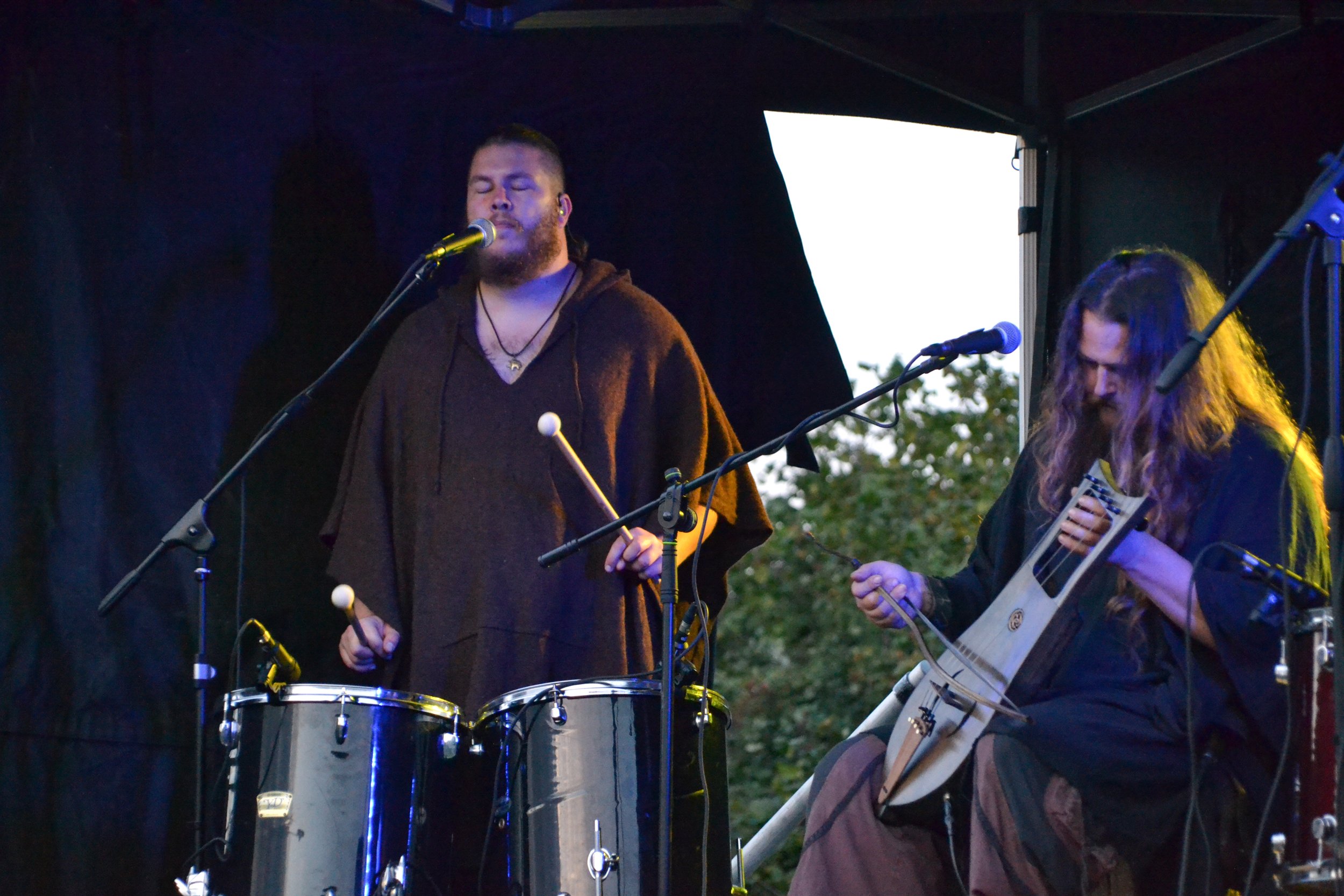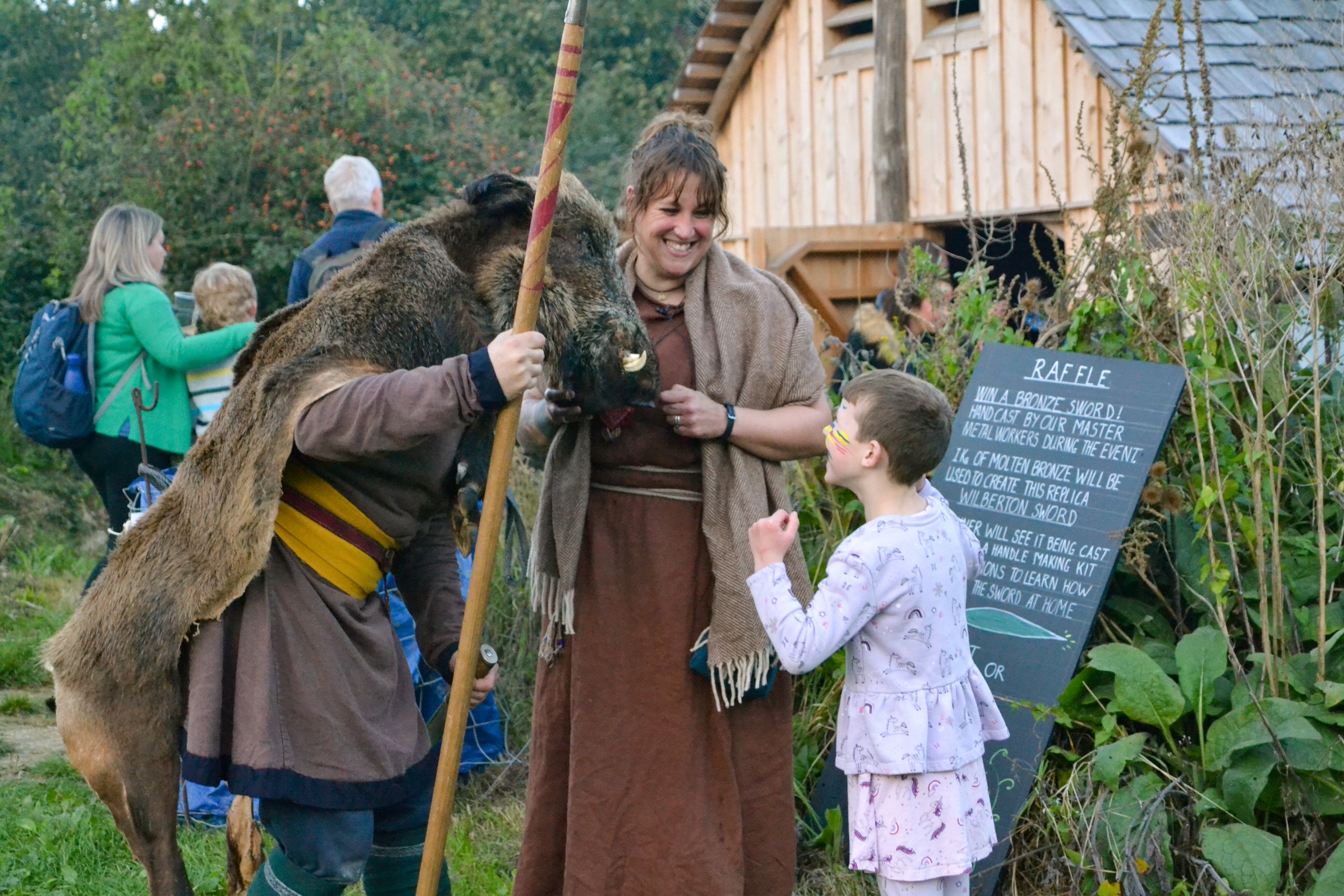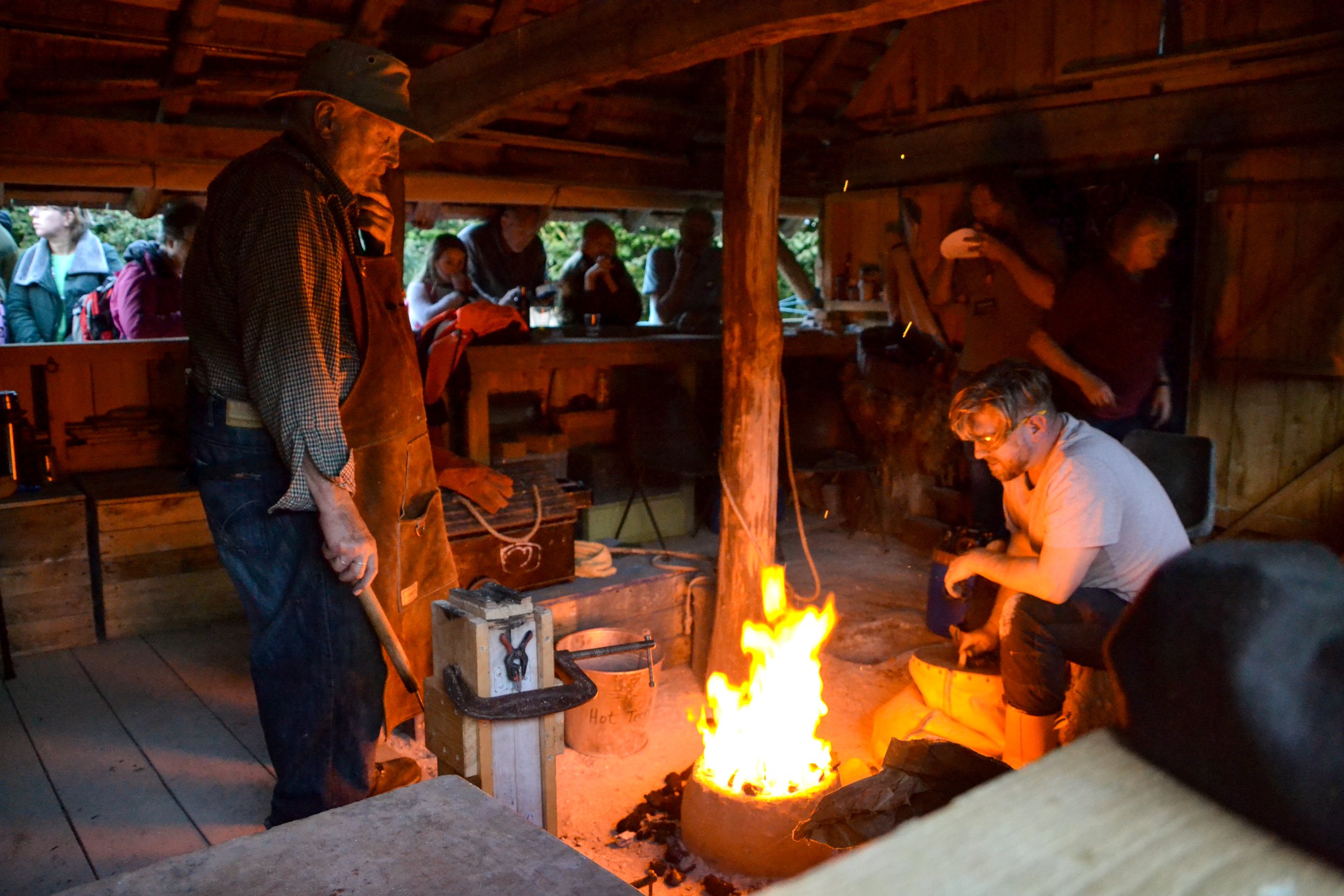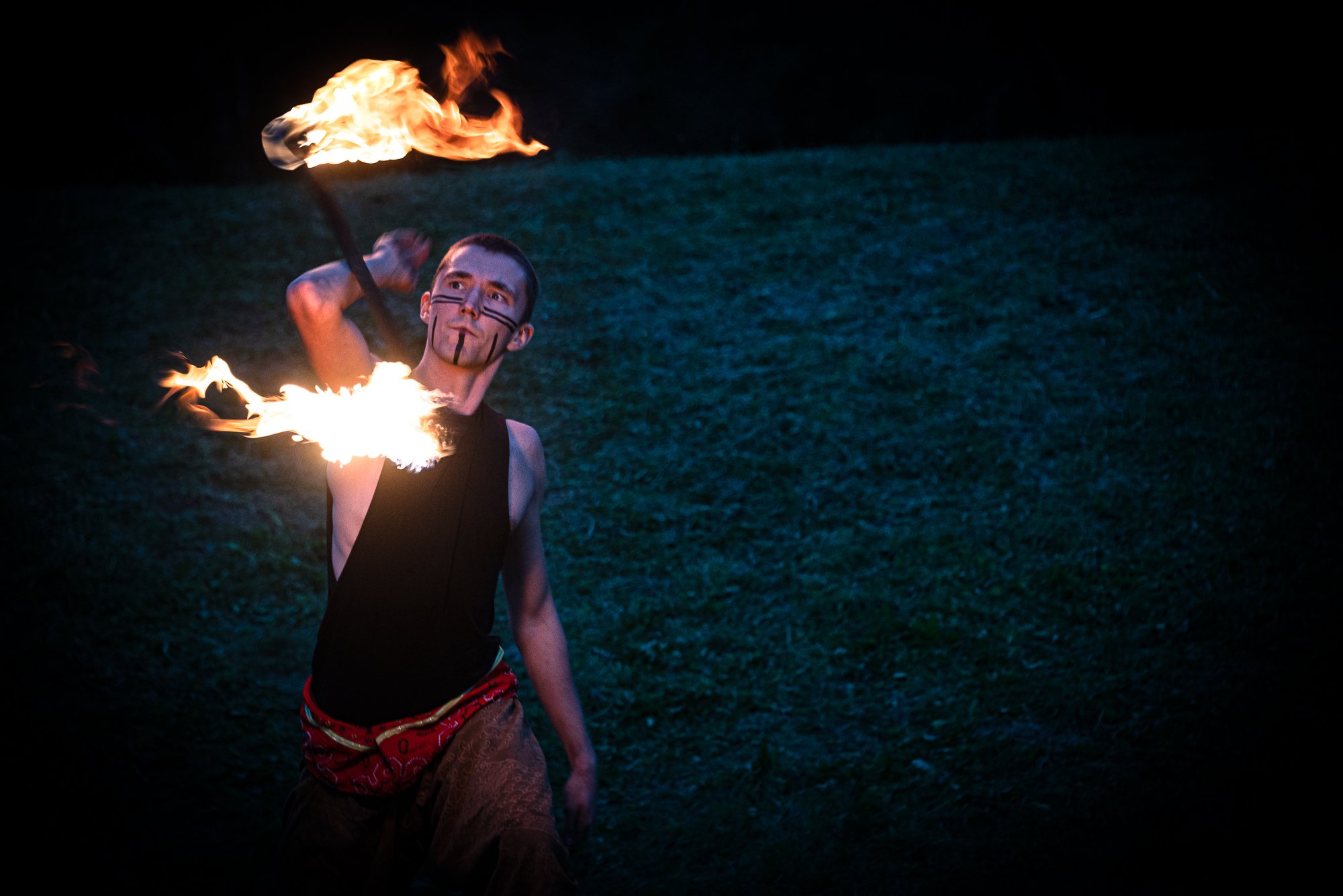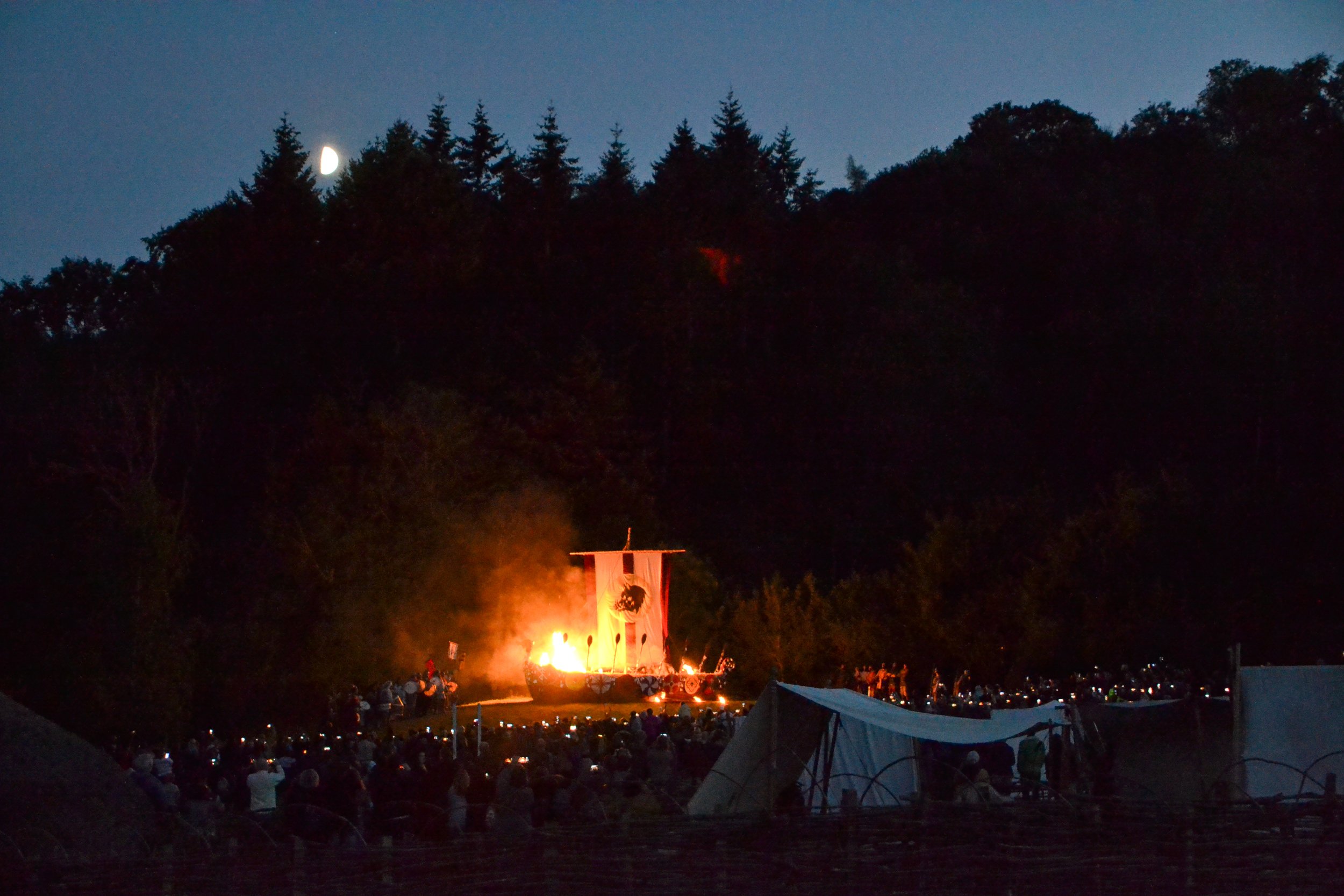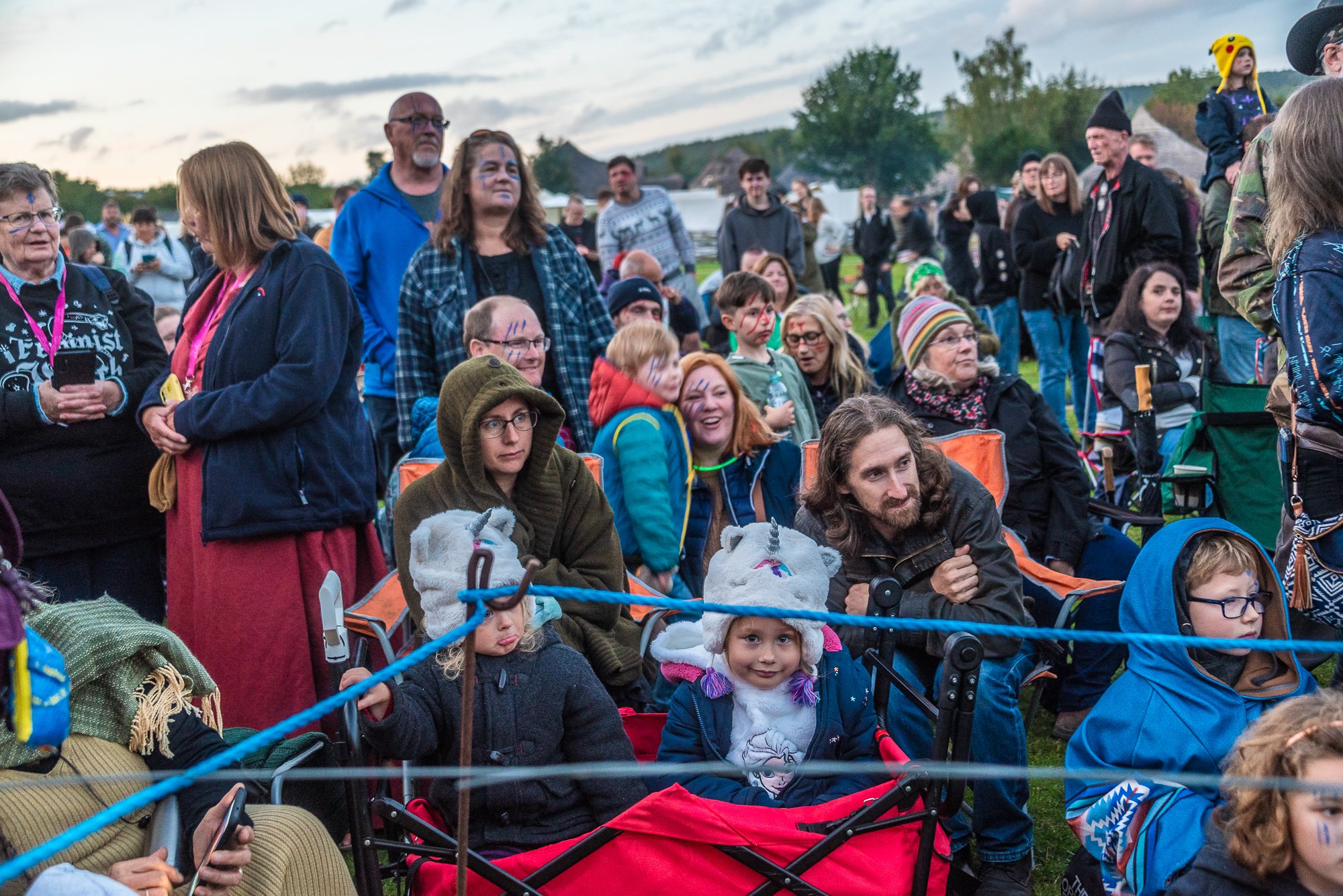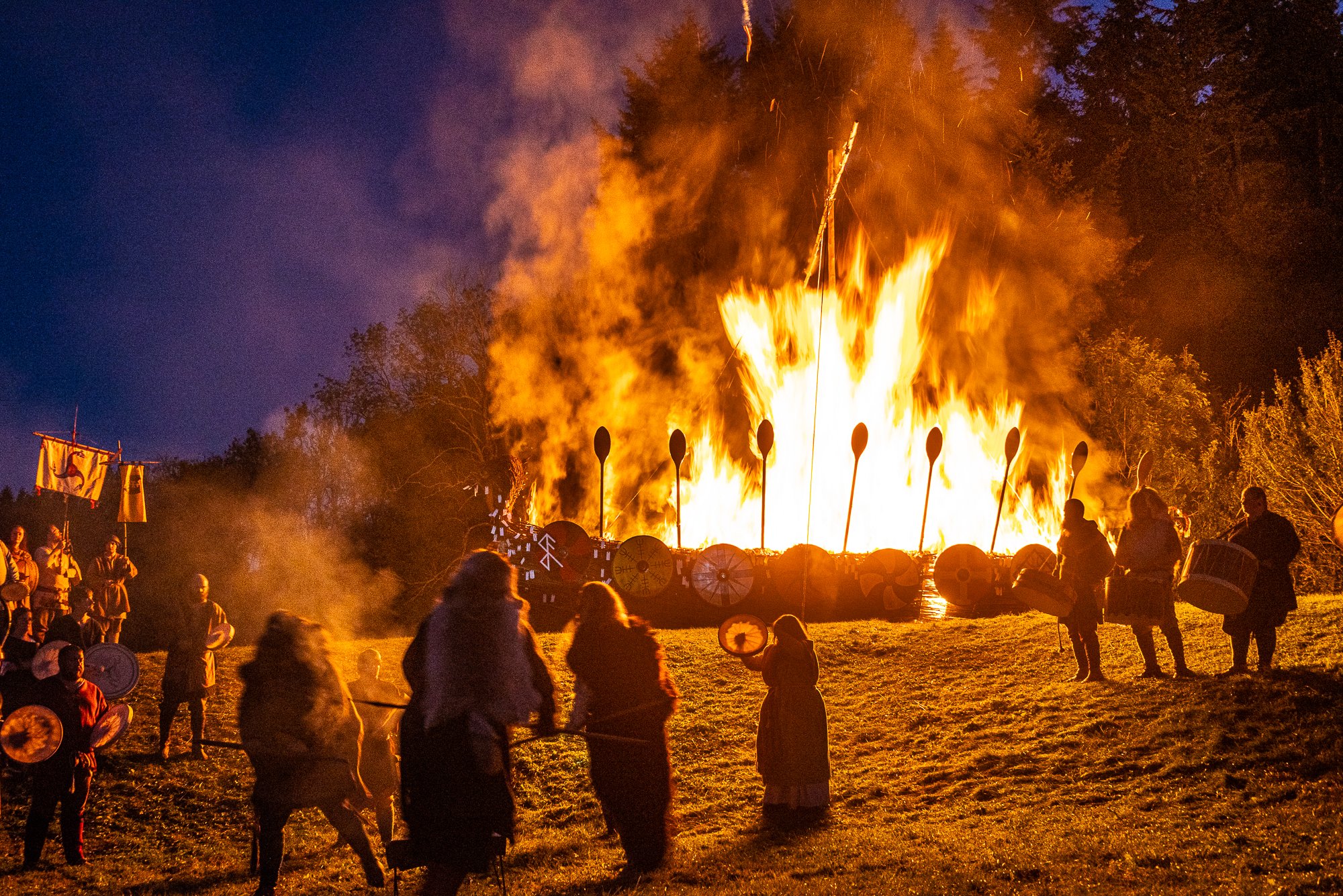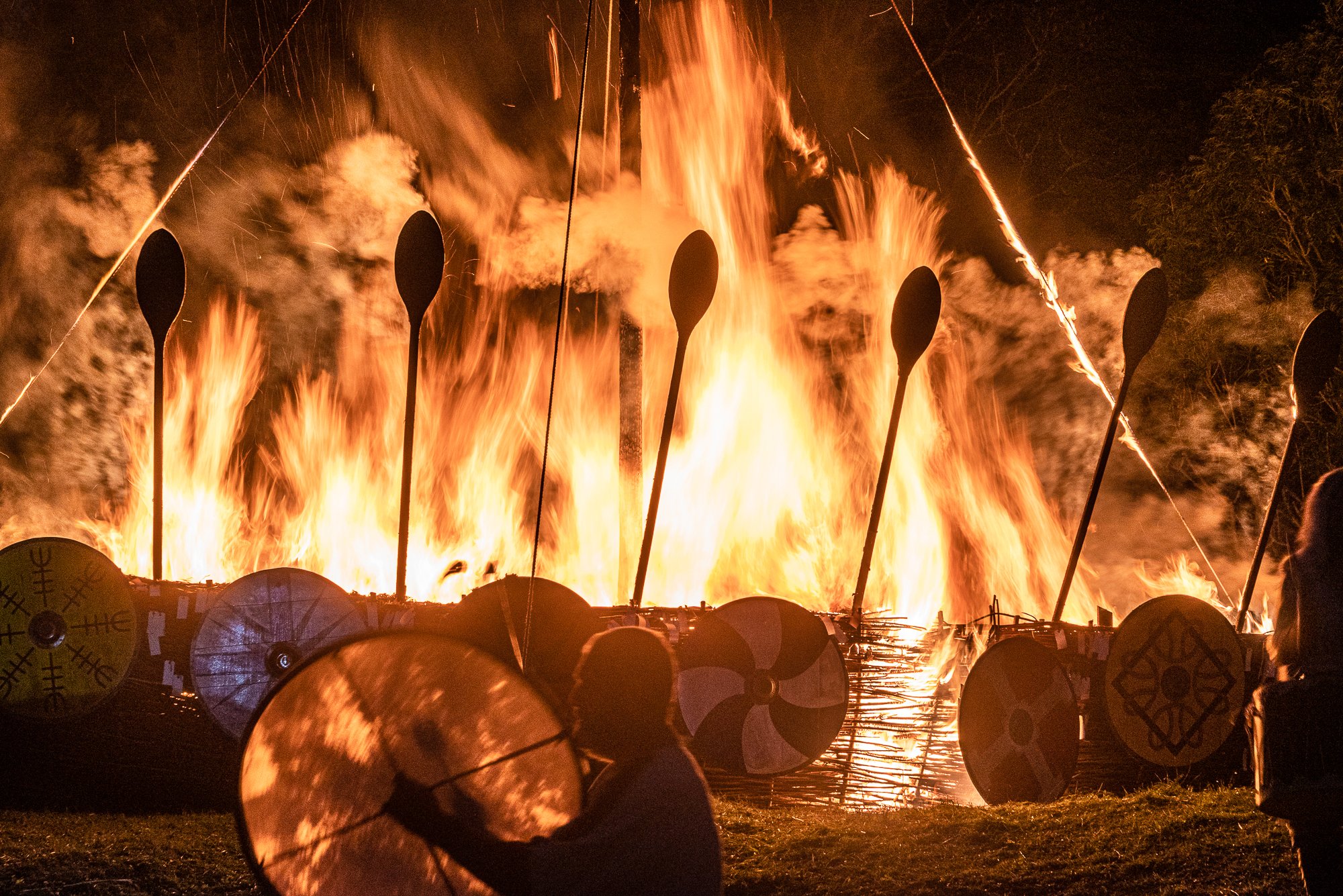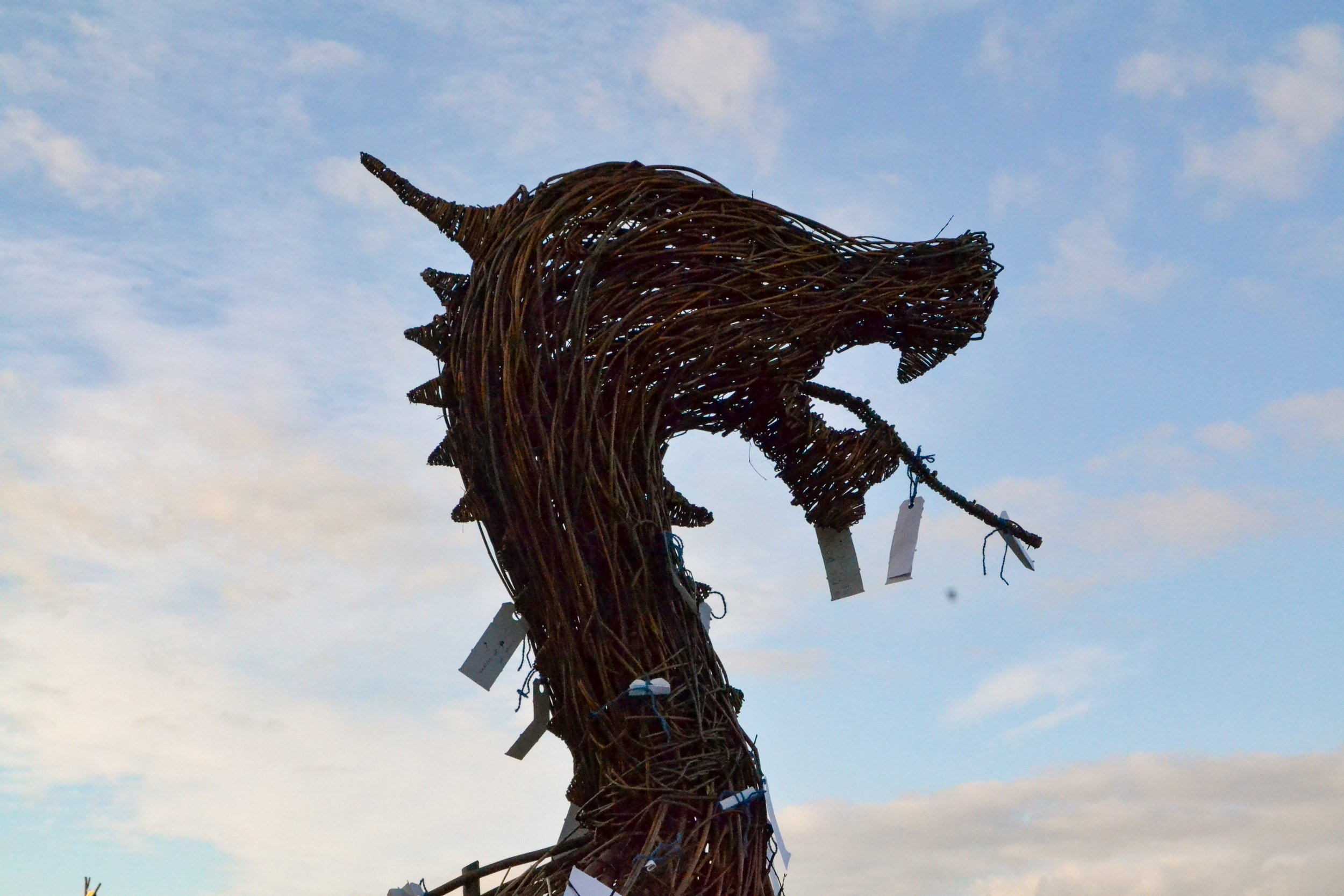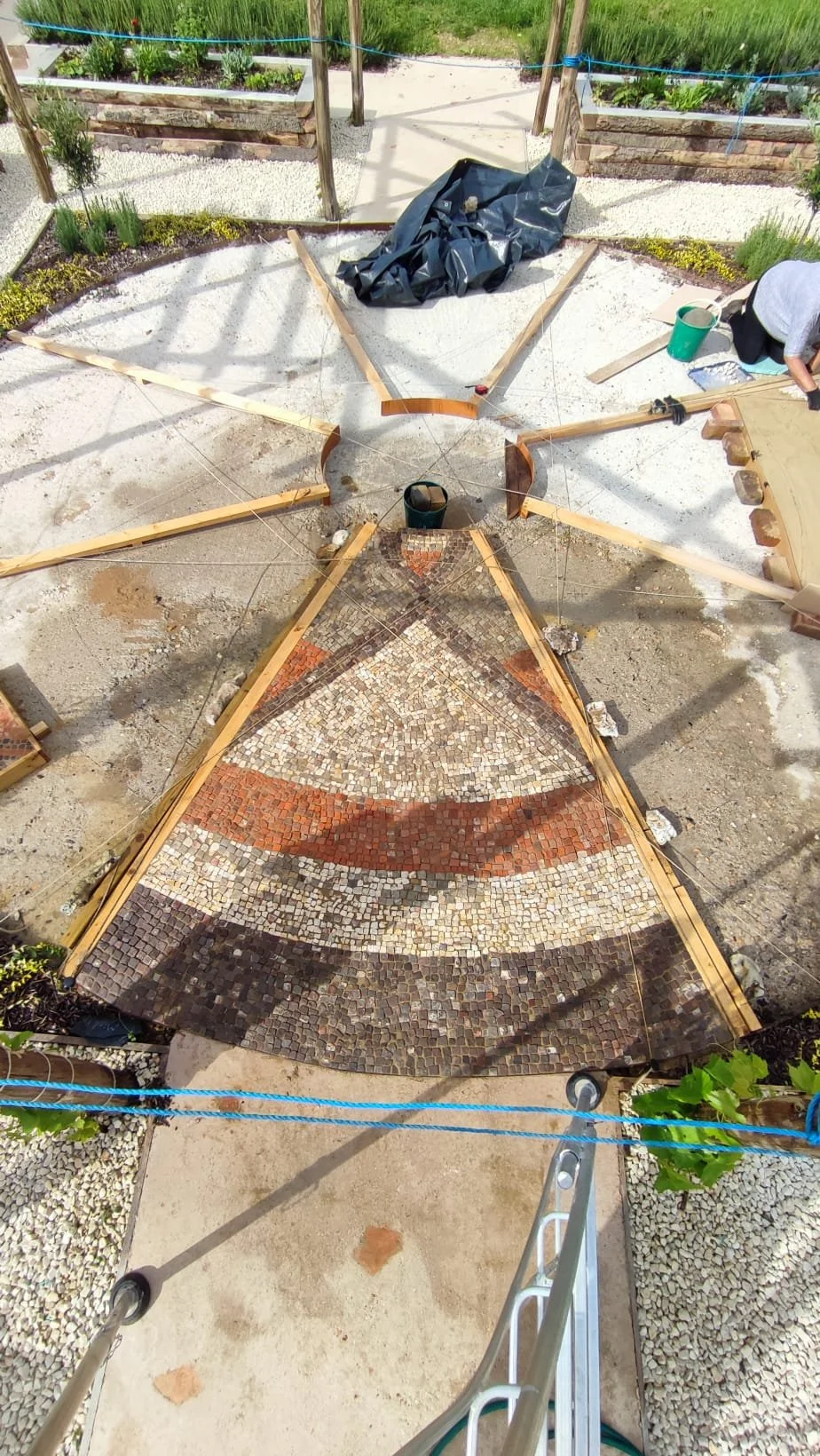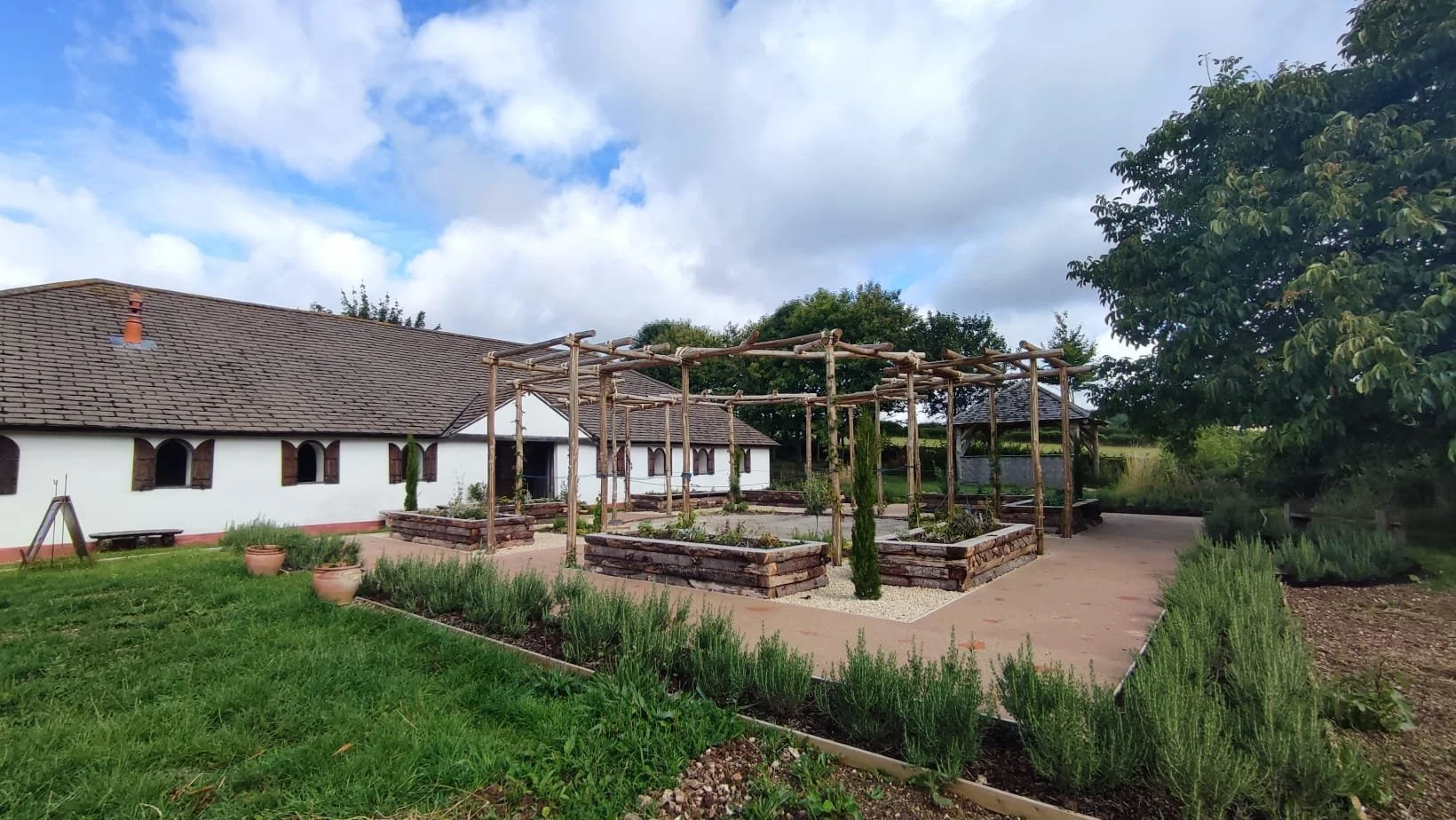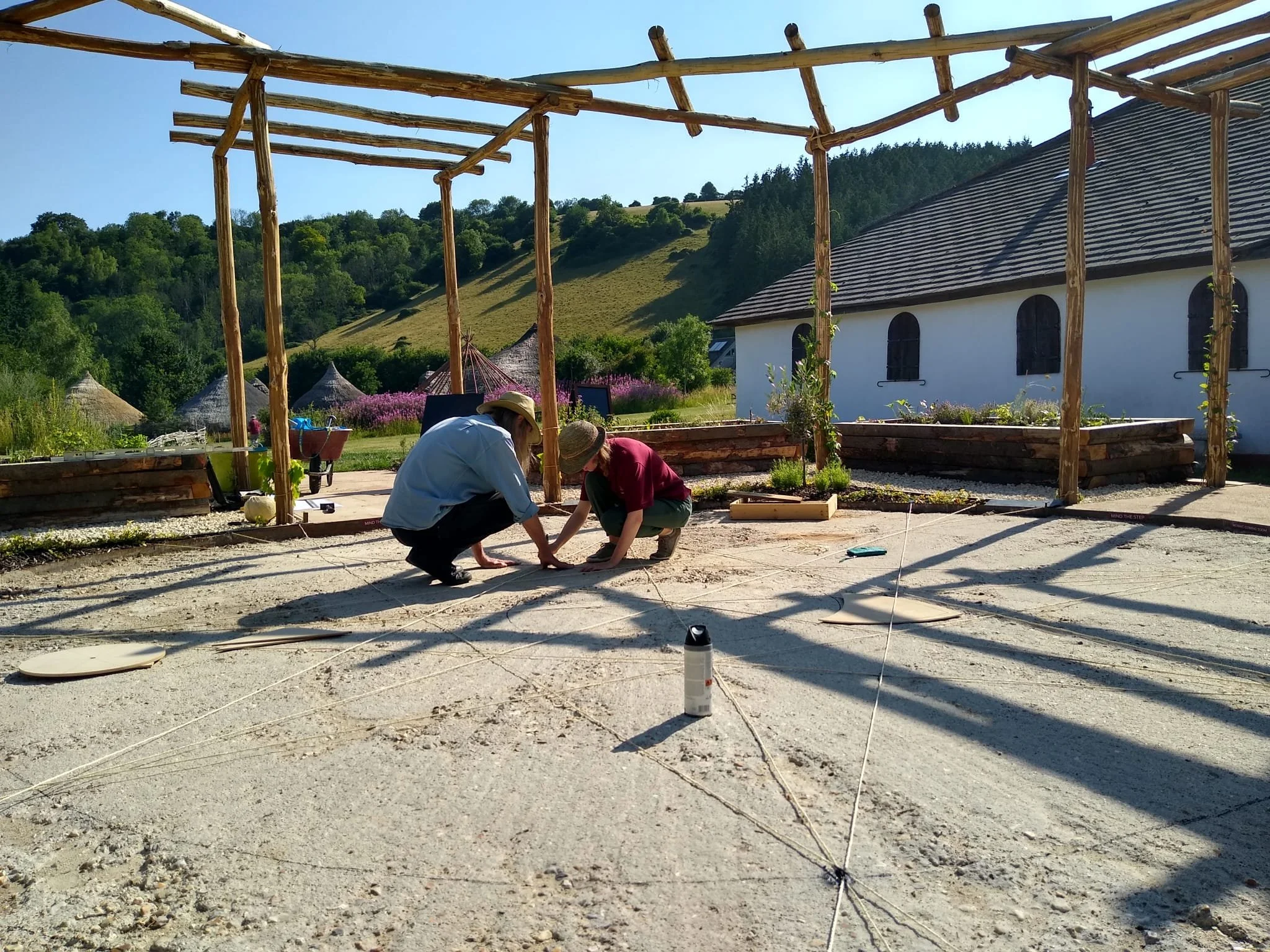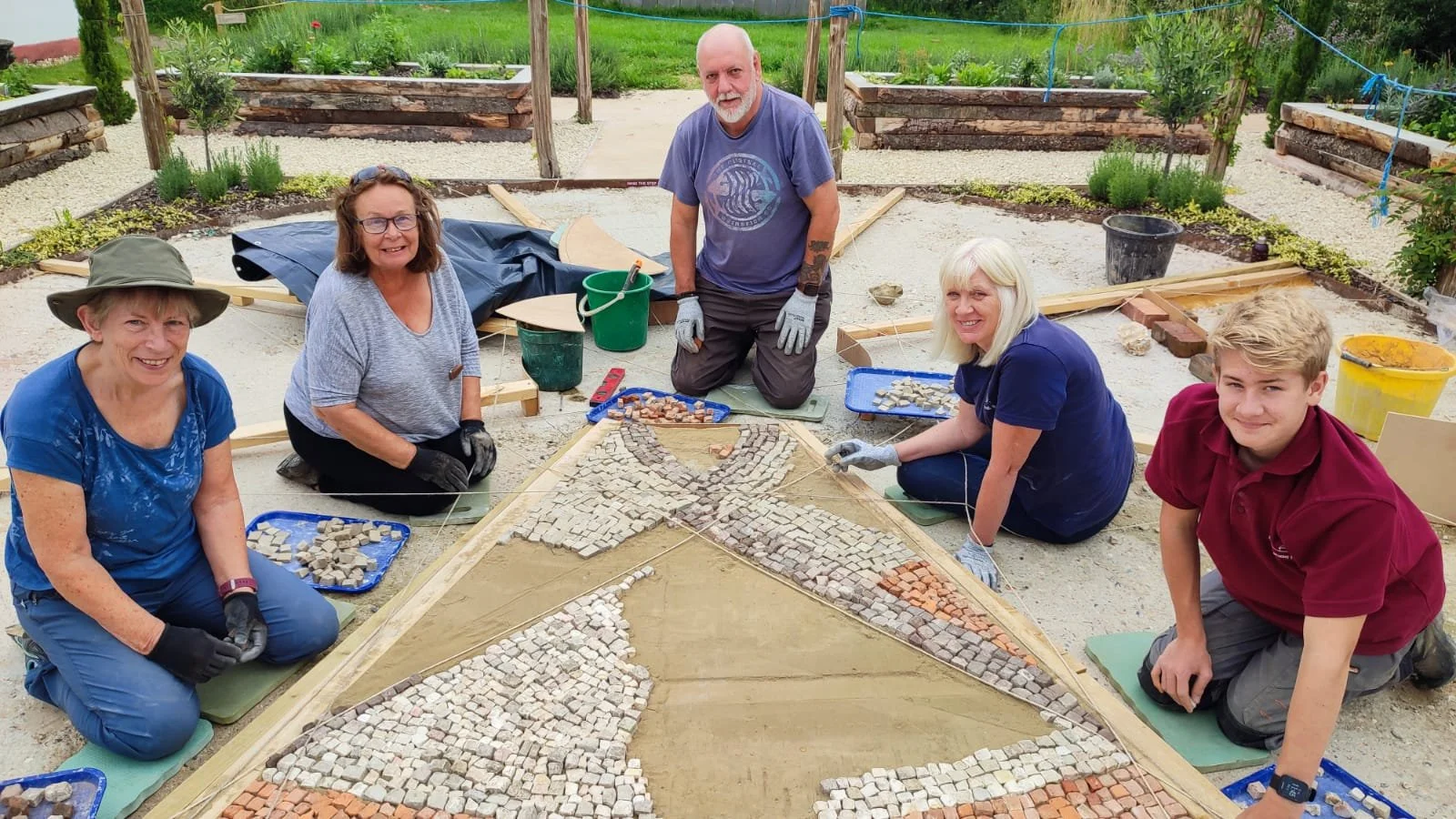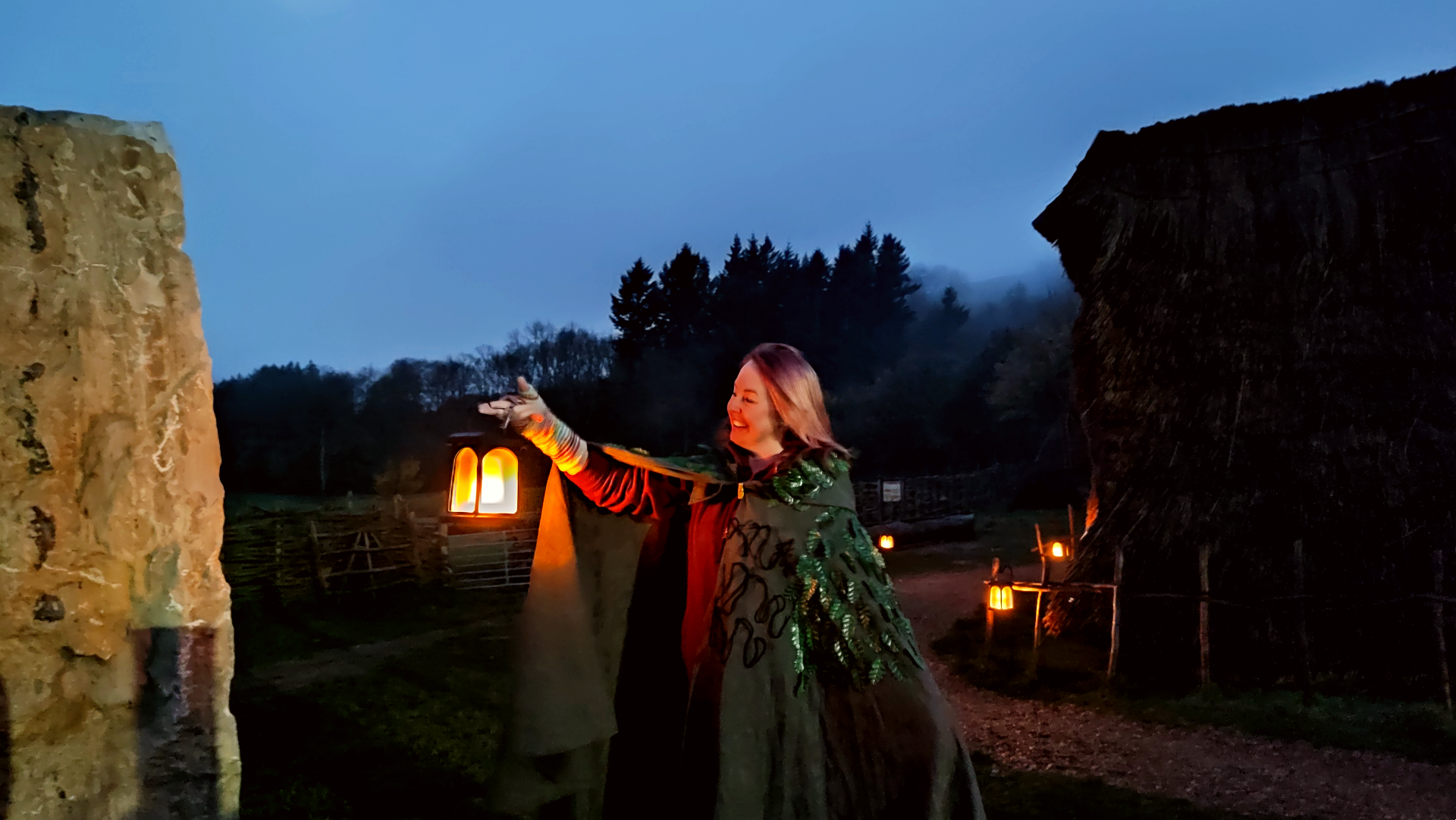
Interior Design Project at Dunch Hill Roundhouse by the ‘Experimentalists’
Margaret Taylor, volunteer Butser librarian and member of the Experimentalists volunteer team, shares an exciting look at the team’s recent projects at Butser.
1300 – 1000 BCE. We are on Salisbury Plain, at Dunch Hill. There is a round house, or at least it seems to be, at first sight, although it may be a stores building. We see a small settlement, where the inhabitants are growing domesticate crops; Emner and other wheats and barley. They have also domesticated sheep, cattle, pigs and horses. This small farm is set in landscape with fences and other field boundaries, with natural woods and grasslands.
We know very little about this house, if in fact it was a house, as this was not necessarily the case in a community settlement, and there wasn’t even evidence of a floor or hearth. In fact, everything about this house is experimental, as the only evidence was the post holes.
This is an ideal project for the Experimentalists, a title suggested for us by John Briggs, of our volunteer team, led by Maureen Page. I joined the volunteer team in late September last year, and am thoroughly enjoying being a member of the group. Since then, we have completed our felted draught excluder for the Danebury Iron Age round house (see The Felters publication below), and a cow/deer skin covering for the Mesolithic shelter. We have also begun working upon deer skins, and we will learn to tan them over the coming months, under the expert eye of Jess, Butser’s workshops and ancient crafts mastermind. However, we are now turning our attention to Butser’s Bronze Age house, from Dunch Hill.
Our aim is to make the house look more homely. First the bed needs to be made more comfortable. We have made a straw mattress, tying together bundles of straw. We completed this in the sunshine of a Thursday morning in early July, with the assistance of Nutmeg, the lovely baby goat. She was quite keen on nibbling the straw, and decided that the best place to have a nap was inside one of the big plastic dump bags!
At the same time other members of our team were breaking up lumps of chalk and making up a ‘paint solution’, mixed with water and applying them to the walls. These will then be painted with artistic interpretations of bronze age designs.
Our next project is to learn how to make a sheep’s wool mattress with a peg loom. We know that our Bronze Age ancestors would have used wool. However, very little evidence has survived, and to find out more about Bronze Age textiles, I read the absolutely fascinating accounts of the lake dwelling houses at Must Farm. Information on this is available in the two open access publications on line (see below), and can be downloaded onto your chosen personal device. They have found evidence of looms and spindle whorls on site but not surprisingly, the catastrophic fire at the site, and the sinking of the houses into the lake has not enabled woollen textiles to survive.
All for now, until the next update - and Maureen has some exciting ideas for us!
If you’re interested, try reading…
Article on Must Farm at Historic England
The Must Farm Pile Dwelling publications - both volumes are fascinating. Volume 1 provides an overview and Volume 2 provides the detailed research techniques etc; the section on materials is very good for discovering much more about their findings.
I would also recommend: Britain BC by Francis Pryor, and Britain Begins by Barry Cunliffe, for overviews of the Bronze Age.
Volunteer resources
If you’re a volunteer, log in to the volunteer section of the Butser website to find resources on all our buildings and periods, including about the Dunch Hill roundhouse.
You can also find Britain BC and Britain Begins in your Butser Library, along with many other titles including this amazing booklet by John — well worth pursuing!
There is a signing in book on the bottom shelf of the library shelves. Please use this, even if the book is not leaving Butser, as it enables us to monitor book loans. When you return the book, please don’t forget to sign it back in!
If you’re not a volunteer with us but are interested in becoming one, find out more about volunteering at Butser here.
Beltain Celtic Fire Festival 2024: Welcoming in the summer!
It’s Beltain! The ancient Celtic festival celebrated at the beginning of summer, and possibly even the origins of May Day. We celebrated this wonderful festival with an afternoon and evening of music, mead, merriment, and of course, the spectacular burning of our 40ft wickerman. Here’s to good company and sunny days!
This year’s wickerman was a bright-eyed, Stone Age stargazer to celebrate our journey building the neolithic Wyke Down reconstruction. Whilst it always feel bittersweet to see our wickerman up in flames, this giant’s presence overlooking our Wyke Down site this Beltain feels like a good omen for the future of our building.
Thank you to everyone who joined us for this wonderful event! To everyone who joined us, to all our visitors and volunteers and supporters here, thank you for making things like this possible.
Stay tuned here for some of our favourite pictures from the event!
relive the magic
Watch the full commemorative video on Butser Plus for as little as £2.99!
beltain celtic fire festival 2024 photo gallery
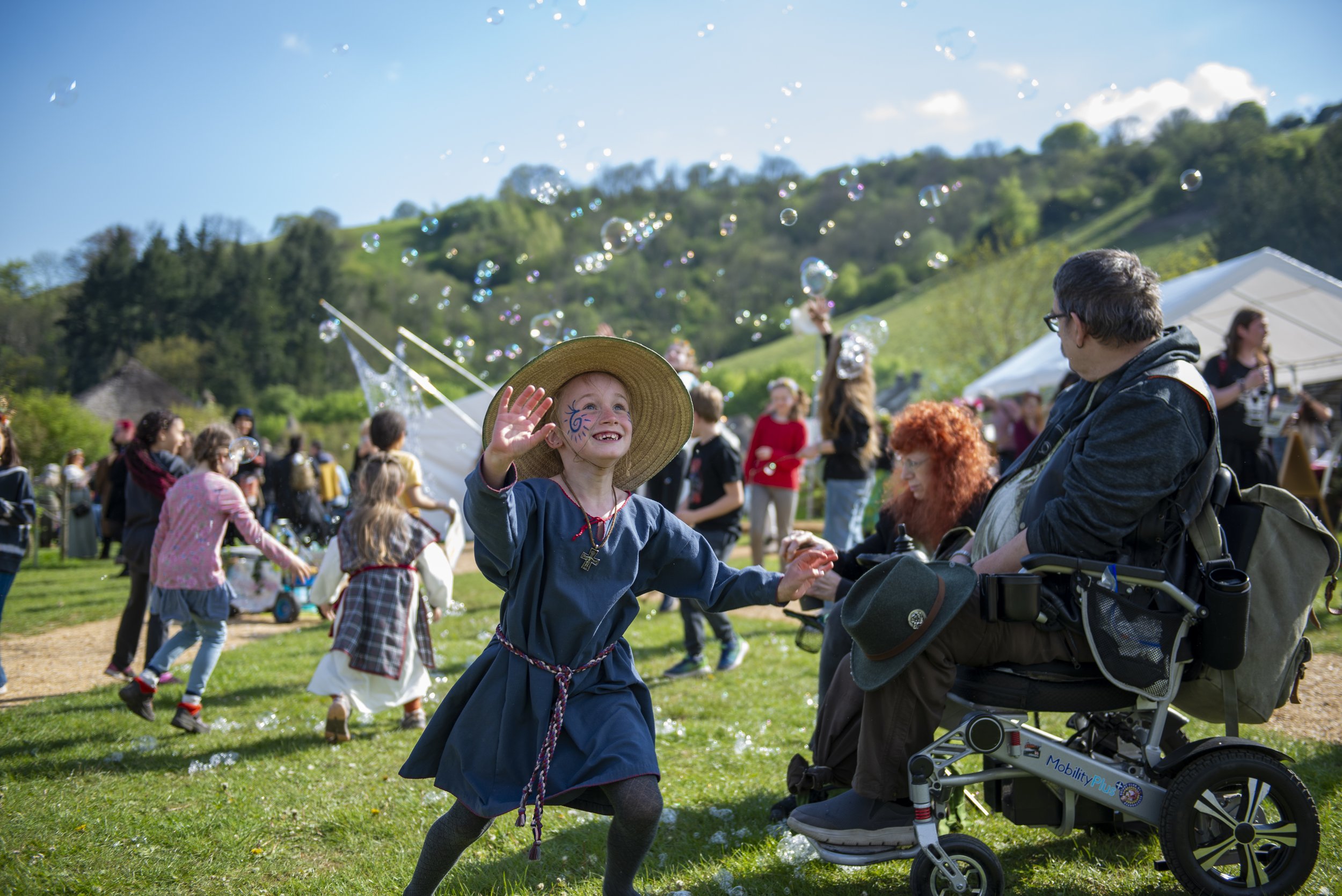


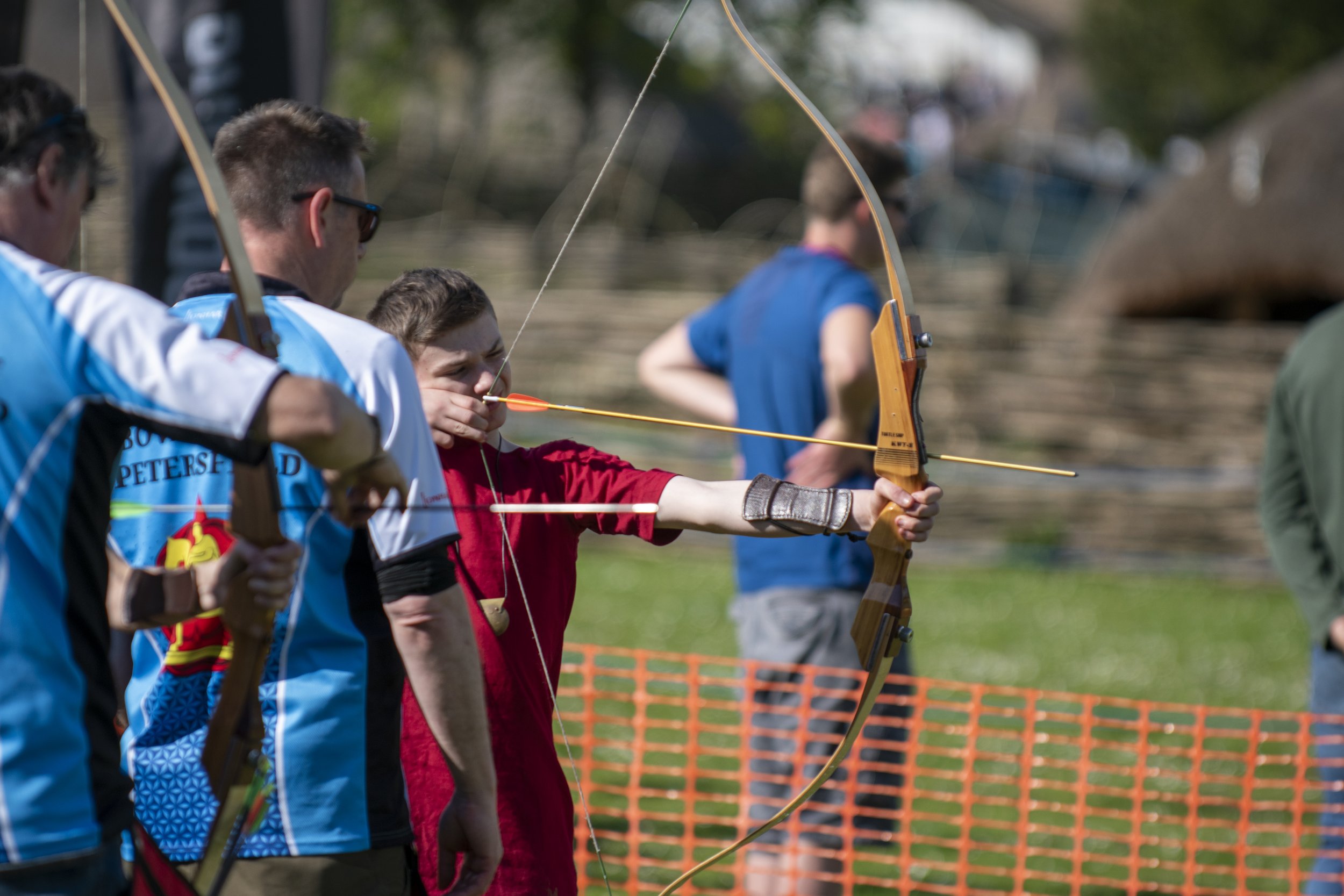


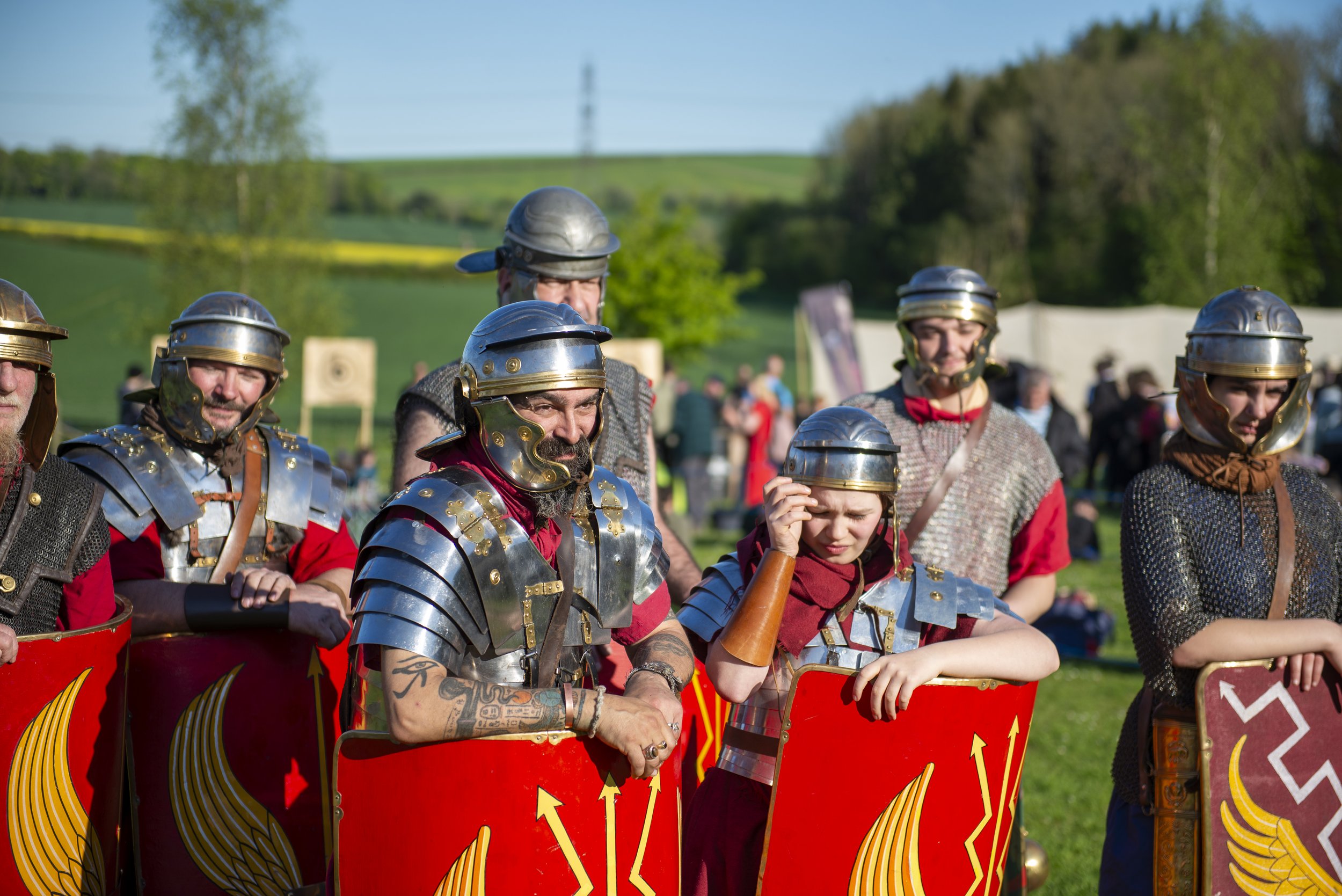

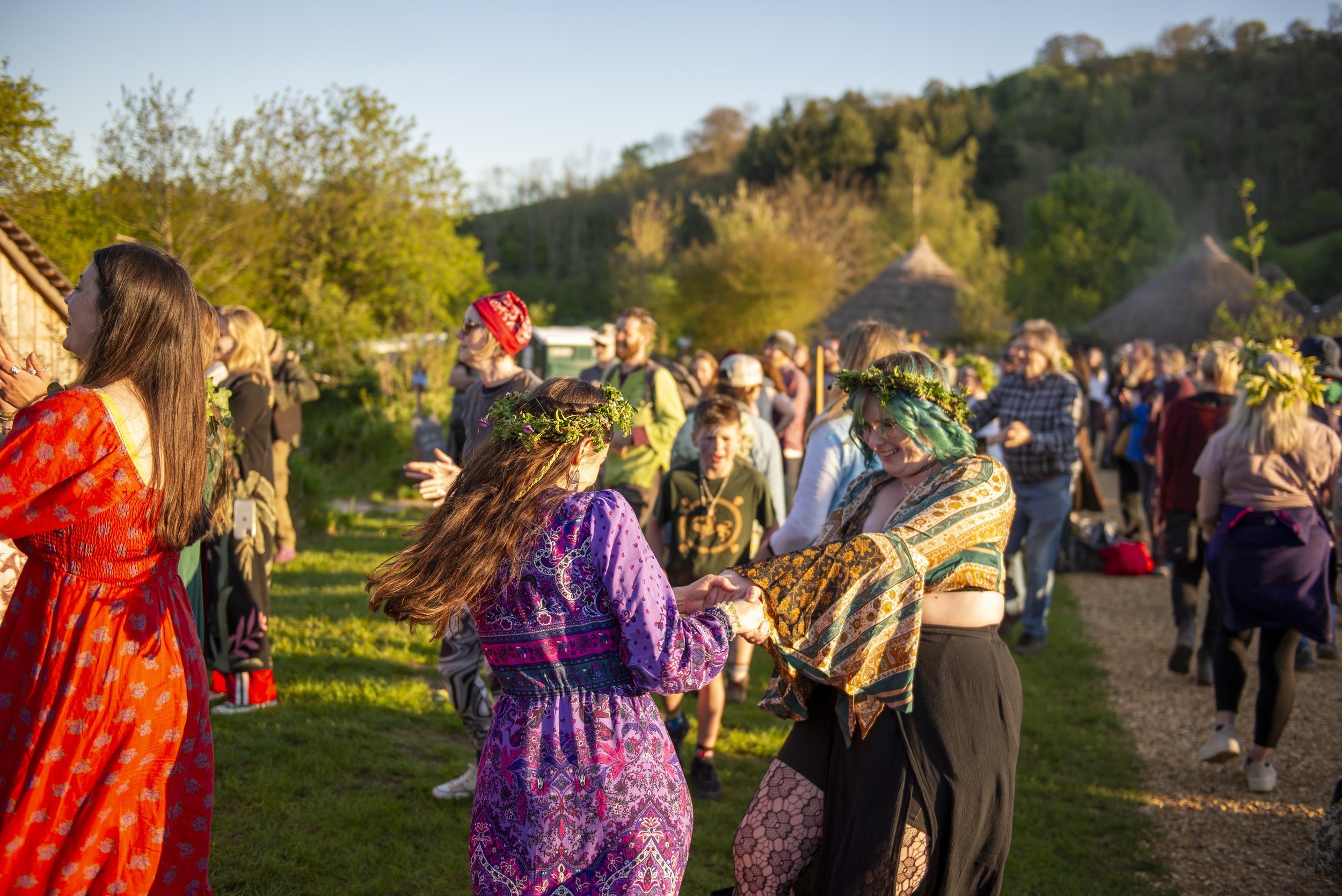
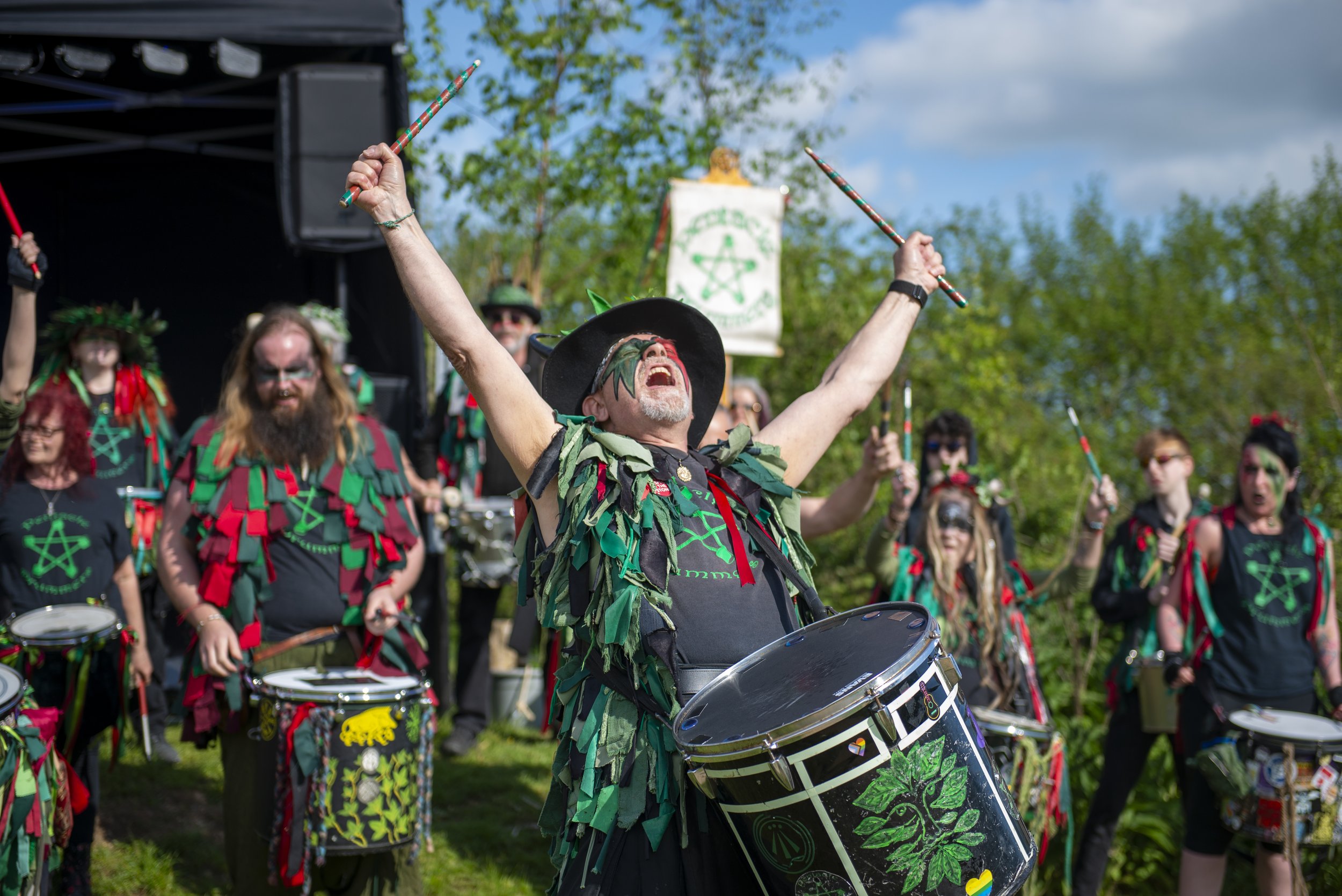

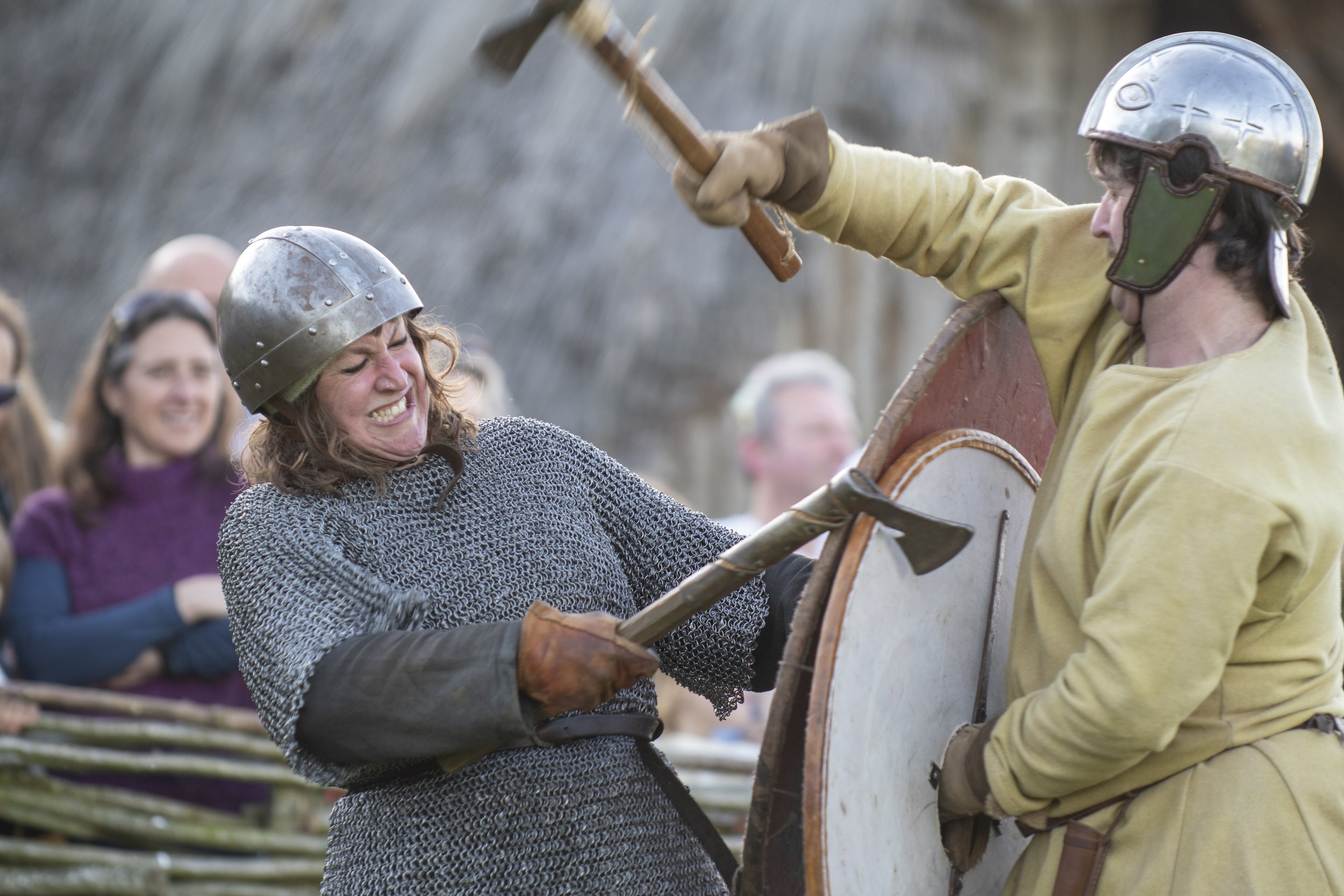








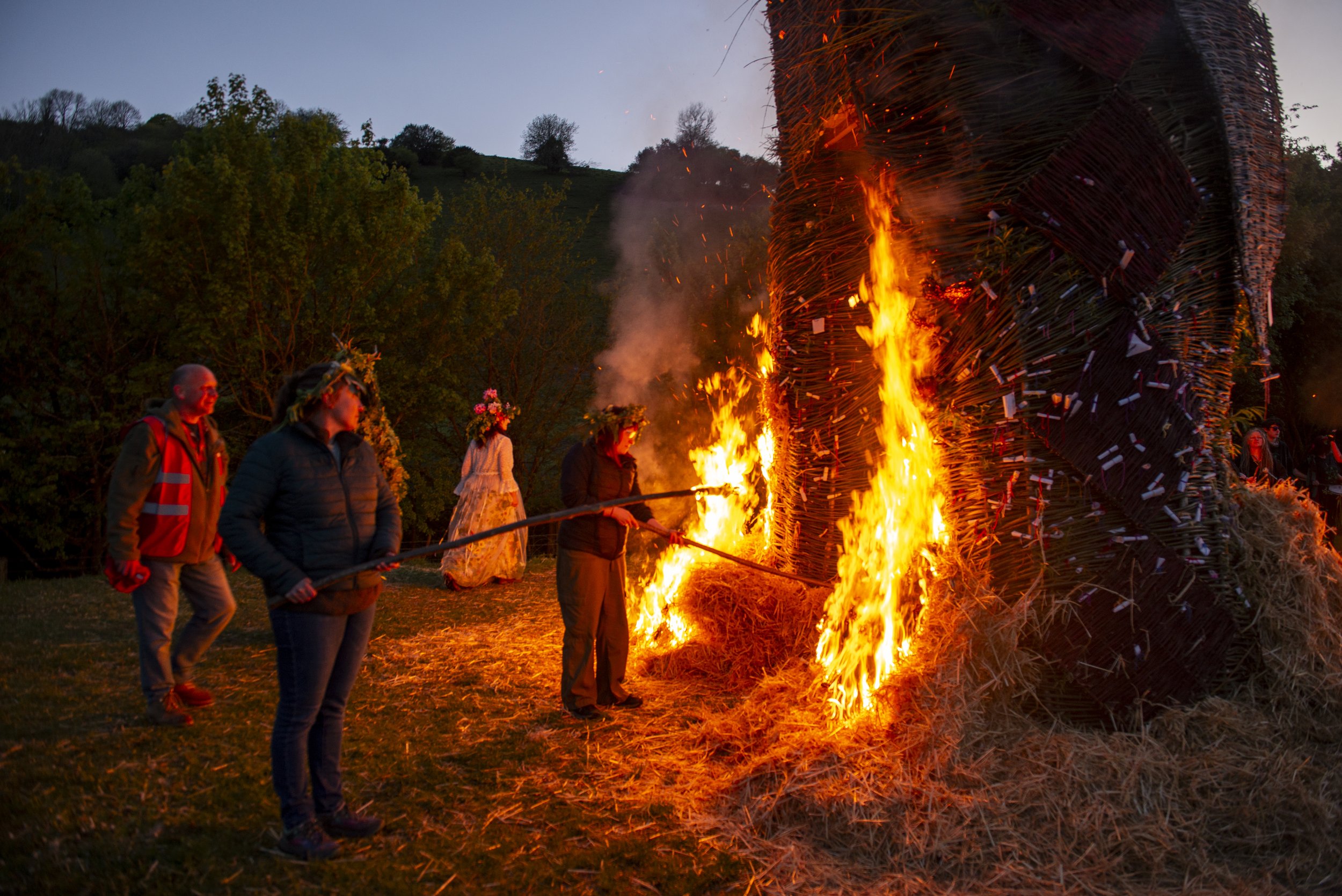



WITH ALL OUR THANKS
We are a small team from a small museum, and Beltain is an incredibly ambitious event for us to hold each year — one only made possible by an incredible number of wonderful people working very hard.
To all our staff and volunteers, thank you for your tireless work in preparing for and running this event! To the Friends of Butser Ancient Farm for your wonderful support, thank you.
To the Saxons of Herigeas Hundas, the Romans of Butser IX Legion, the ancient musicians of Here Be Flagons, to all the other reenactors and living history practitioners who helped bring our ancient farm to life, and to everyone who turned up in costume — thank you.
To the iconic Feckless who always gets us up and dancing, to the brilliant bards of Fae as Folk, to the energetic Courtiers, to the dynamic duo of the Folk Bus, to the the song-master Damh the Bard, to the beautiful sounds of Liz Overs, to the endlessly energetic Pentacle Drummers, and to the classic Ukes of Hazard, thank you for your wonderful performances.
To Jen Atkinson, Kit Helme, Jon Wylie, Tom Bird and Martin Green, thank you for your wonderful talks on herbs, cunning women, singing, dying, foraging and archaeology. To Beltane Border Morris, Flying Iron, the Bowmen of Petersfield, Steamship Circus, Ostara the Bubble Fairy, Jez Smith, and Eva Greenslade, thank you for your work offering unique and incredible performances and experiences, from handfasting to axe throwing to archaeoacoustics.
To Neil Burridge, Corn Dollies by Brigid, Joe the Smithy, Craig the Saxon Forager, Fergus Milton, Jim Clift, and everyone from Colchester Historical Society and the Ancient Wessex Network, thank you for your wonderful demonstrations of ancient crafts and metalworking.
To Jonathon Huet and Dawn Nelson, thank you for bringing such magic with your wonderful stories.
To HantsAstro for your interesting and interactive stall, thank you. To Chalice Mead, Three Copse, the Whitelands Project, Langham Brewery, Mr Whiteheads, and Blackmoor Estate, thank you for supplying us — whether that’s with mead, local greenery, or our very own unique Beltain Cider!
To craftsfolk and traders Butser Crafts, Feral Fibres, the Wood Beyond the World, Intelligent Hand, Pixie Made, the Special Branch, Kevan Dyne, Silverstrand Jewellery, Chris Page Design, Minerva Crafts, Wesnet Services, Pipers Honey, Wild Willow, Luna Skies Creations, Hare and Tabor, Finn’s Fire and Woodcarving, Woody Wonders Twig Pencils, Haus of Paint, Tangled Muses, the Special Branch, Gina McAdam, Amongst the Gorse, Fantastical Kingdoms, Woolleymamma Leather, Willow and Crafts, Petal and Plume, and Gwen’s Garden — thank you!
To Crêpe Britain, Matt with the hog roast, Earth to Oven, the Cookhouse Street Food, Eden Eats, Off Grid Espresso, Stable and Ground, and Sharon and Wendy of the Butser Bakes stand, thank you for all your work to feed everyone!
To friends unnamed but not forgotten, thank you.
And finally, to our supporters on Butser Plus, to our visitors, and to you 💚
Win a free family ticket for 2024 this winter!
It’s the season of giving! To celebrate the return of our magical Midwinter Quest, we’re giving away a free family ticket every weekend! Read on to see how to enter…
Midwinter magic at Butser
By popular demand, the Deer Queen is back at Butser! Meet her and the Holly King on Midwinter’s Magical Quest, and step into a winter wonderland at Butser for a fabulous festive adventure. Discover winter folklore and escape the commercial holidays on this unique non-denominational day out!
Swap Santa’s grotto for the firelit den of the Deer Queen, or the evergreen hall of the Holly King. Meet characters from winter folklore, and help them restore the light to the land with their magical trail! That’s not all — get hands on with make-and-take crafts to create gifts and decorations, and say no to plastic by using all-natural materials. Explore our ancient houses transformed by winter magic, and get immersed in winter traditions from a simpler time.
Win a family ticket every weekend
We’re celebrating alternative family days out this winter, and that’s why we’ll be giving away a free family ticket every weekend. One lucky family who joined us on the quest will receive a free ticket for up to two adults and two children, to be used any time in 2024.
Here’s how to enter:
Join us for Midwinter’s Magical Quest on any of the days it’s running.
Take a picture of your merriest midwinter moment! Dress up for the quest, show off your crafts, take a picture with the Deer Queen or Holly King… Whatever makes you feel merry!
Show us your merry midwinter photo on Facebook or Instagram. Don’t forget to tag us and use the hashtag #ButserMidwinter to be sure we see!
We’ll pick our favourite photo after each weekend. Make sure you’re following us so we can send you your tickets if you win!
We can’t wait to see your merriest midwinter photos! Terms & conditions apply.
A royal celebration for our new Roman garden
After a year in the making, hundreds of volunteer hours, and over 10,000 authentic Roman tesserae (mosaic tiles), our formal Roman garden is finally open — and we couldn’t be more delighted!
Today marked the official opening ceremony, and we had the distinct pleasure of hosting a very special guest to officiate. His Royal Highness Prince Richard, the Duke of Gloucester, has a keen interest in architecture and historic buildings, so we were delighted that he joined us to officially open our new Roman garden.
20 years in the making…
The opening of the new garden couldn’t have been more perfect — the villa itself opened 20 years ago this October, so what better way to celebrate than giving it the formal entranceway it deserves?
It’s also a great example of how our work at Butser is never done. In the 20 years since the villa was completed (the first to be built in the UK for over 1000 years!), it’s seen numerous renovations and redesigns as archaeologists’ understanding of Romano-British villas and aesthetics have changed. The biggest renovation was in 2018, which is also when we laid our very first mosaic — amazing to think that in just a few short years we’ve gone from no mosaics to three!
A Roman country garden
The new Roman garden has quickly become one of our favourite places at Butser — and we hope if you visit you’ll see why! It beautifully represents the types of garden features and plants found in Romano-Britain. We go into it more in our video on Butser Plus, but it’s filled with 65 varieties of plants either indigenous to Britain or introduced by the Romans themselves. At the centre lies a stunning mosaic made of over 10,000 authentic Roman tesserae (tiles), rescued in a dig from under the M4 and generously donated to us for this project.
In fact, none of this would have been possible if it weren’t for the kindness and generosity of our supporters. This garden was entirely funded in memory of Joan Rundle, a long-time Butser volunteer and Friend of the Farm with a special interest in Roman gardens and their plants. May her legacy long stand at Butser and be enjoyed by thousands of people in the years to come.
a royal opening
What better way to celebrate the completion of this special project than with a special opening ceremony? We were honoured to be joined by the Duke of Gloucester, and gifted him a replica bronze axehead crafted on-site to say thank you. After a guided tour of our ancient buildings, the Duke saw demonstrations of timber framing and metal-smelting in action, and even met some enthusiastic students on their school trip! Finally, the Duke officially opened the garden and mosaic to an audience of the original villa build team, mosaic and garden volunteers, and local dignitaries.
We’re incredibly proud of the work we do at Butser, and the things our dedicated little team can achieve, so it means a lot to us to have this kind of support and recognition from a royal visit. The last time we were visited by a royal was in the 70’s, when the queen herself visited Queen Elizabeth Country Park and Butser Ancient Farm, and met our founder Peter Reynolds!
The growth of Butser
Everything we do at Butser is a labour of love, and this garden is such a perfect example. But gosh, it’s so worth it. Just a few months ago, the area outside the Roman villa was just a patch of grass — what a difference some time and love can make!
In many ways, the growth of the villa reflects the growth of Butser itself. Our director Simon was a member of the original villa build team — and, as he says, it ‘hooked’ him on Butser. We’re all so proud of how much this little site has grown in the last 20 years, from a small research site barely open to visitors to a thriving centre that hosts over 60,000 visitors annually, all eager to learn about our rich past. The research is still at the heart of what we do — but now, we share it with more people than ever before.
So… What’s next?
You know us, we never sit still for long. We’re already working on our next big project: a Stone Age roundhouse that would have looked out over a wood henge! We’re so grateful for the incredible support that allows us to keep experimenting, keep learning, and keep sharing our work with as many people as we do. We hope you love the Roman garden — and what comes next — as much as we do!
Want to help us keep experimenting, and join us on the journey? Support at Butser Plus for the price of a coffee, and get documentaries and updates on our latest projects!
Equinox Viking Boat Burn 2023: Sending a warrior to Valhalla
We celebrated the autumn equinox with an afternoon and evening of living history, live music, and lots and lots of fire. Thank you for joining us by the flames!
Last weekend, we celebrated the autumn equinox and sent off the summer in style with an incredible evening of living history, live music, and lots and lots of fire.
We burnt this year’s majestic Viking longship at dusk, after the climactic battle between Vikings and Saxons. Which side did you cheer for? Was it one of your tribe’s warriors who fell?
Thank you to everyone who joined us for this festival and helped to make it so special! To everyone who made it out, to all our visitors and volunteers and supporters here, thank you for making things like this possible — may your mead cup be ever-full!
Stay tuned here for some of our favourite pictures from the event!
Relive the magic!
Watch the full commemorative video on Butser Plus for as little as £2.99!
Photos from Equinox Viking Boat Burn 2023
With all our thanks
We are a small team from a small museum, and Equinox is an incredibly ambitious event for us to hold each year — one only made possible by an incredible number of wonderful people working very hard.
To all our staff and volunteers, thank you for your tireless work in preparing for and running this event! To the reenactors of Herigeas Hundas, Wuffa, and Jotunn’s Wrath, the musicians Per Kelt, Solfyr, and Seidrblot, the performers of Steamship Circus and Mythago — thank you.
To Mark Ford of Two Circles Design for creating a truly incredible longship, and Wendy Vincent-Spall for making an iconic sail. To Leofric Designs for hand-crafting our beautiful Equinox Drums, to Jim Clift for making a bronze sword for the raffle winner, to everyone who gave a talk, demonstration, or a story, or who worked to provide food, drink, entertainment, or wares.
To friends unnamed but not forgotten, thank you.
And finally, to our supporters on Butser Plus, to our visitors, and to you 💚
A new mosaic for our Roman garden!
Project Archaeologist Trevor Creighton shares the story behind our latest exciting project to create an outdoor mosaic in our new formal Roman garden.
Project Archaeologist Trevor Creighton shares the story behind our latest exciting project to create an outdoor mosaic in our new formal Roman garden.
The formal Roman garden under development
Laying out the Mosaic pattern framework
After months of planning we’re excited to be starting a new mosaic project at the farm this summer. This will be our third but, unlike the other two, our latest mosaic won’t be inside the Roman villa but outside, set in a beautiful new garden opposite the villa’s front door.
To build it, we’ll be using recycled tesserae set into a base of sand mixed with cement. The design of the new mosaic is the brainchild of Butser’s creative developer Rachel Bingham, with valuable input and elegantly made formwork for setting out the large, 25 square metre design from her father and Butser volunteer, John. It will feature a geometric design that resembles an eight-petaled flower, surrounded by concentric circles, contrasted with different coloured stone and terra cotta tesserae (tesserae are the small, roughly cubic tiles that make up the mosaic patterns). The mosaic will feature a central decorative design, like an eight-petaled ‘flower’ in the centre.
The geometric design for the Mosaic
It is a large version of a similar design found in the centre of our large indoor mosaic, which is in a room opposite the front door of the villa, just across the footpath from our garden. The original of that mosaic was uncovered in the excavation of the Roman villa that ours is based on, which was found at Sparsholt near Winchester. So, while there is no evidence of any outside mosaic at the original villa, the new mosaic design reflects one that we know existed in the original villa in the 4th century. We also have a beautiful Lararium, or household shrine, that sits at the rear of the villa’s mosaic room and it, too, features the same flower-like design. We think that the repetition of this motif gives a wonderful harmony and authenticity to our new garden mosaic and its relationship with the villa.
Calçada photographed in Madeira
We have little information about outdoor mosaics in the Roman world, so ours will be constructed in a similar way to a modern pavement, being laid into a dry mixture of sand and cement that will be wetted after the mosaic is laid. Once the water penetrates the sand and cement mix it will cause it to set and so stabilise the mosaic. This technique is very similar to the construction of calçada - type of mosaic cobblestone pavement used extensively in Portuguese streets and which in turn dates back hundreds of years.
Vitruvius, the great architectural commentator of the Roman world, described what we might call the ‘classic’ way of constructing a mosaic. His method involves laying down a base of coarse gravel or stones, on top of which is laid fairly coarse concrete, with a final, thin layer of fine, wet mortar laid across the top of that, into which the tesserae are set. This is clearly quite different from the method we are using. The reason for this is that it is not practical to lay a large, outdoor mosaic into wet mortar – doing that would create a lot of difficulties, not least because the mortar would set too quickly. The concrete and mortar used in making Roman mosaics was also somewhat different to the modern cement that we will be using, again for practical reasons.
Just in case you think we’re departing too much from the Roman model, it's worth pointing out that both Roman and modern cements are lime-based, as we'll see in the discussion below. And, despite Vitruvius’ excellent method, more mosaics probably deviated from his advice than obeyed it, and this included laying them over bases of sand. What's more, our recycled tesserae come from a demolished Roman villa! They came from a villa at Badbury in Wiltshire, which was destroyed by the M4 motorway when it cut through east-west just south of Swindon. They were rescued by Bryn Walters from the Association for Roman Archaeology, who has a long association with Butser and kindly donated for use here at the Farm.
After talking so much about the materials we are using to construct our mosaic, I thought it would be useful to have a brief discussion about them and the surprising history of their use, so here we go…
Mortars and concretes are mixtures of sand and/or gravel (called aggregate) bound together with a cement and water. Strictly speaking, cement refers to the dry binding material, which is usually made from burnt limestone and which hardens after being mixed with water. Mortars and concretes are very similar to each other in terms of the materials that go into making them. Typically, concrete has more cement and coarser aggregate to give it more strength. Mortar, on the other hand, is mixed with slightly less cement and a fairly fine sand. Concrete is used in things like building foundations, which need to be strong and resilient, whereas mortar is used for applications like binding stone and brick in walls and tesserae in mosaics. Modern cement, which is known as Portland cement, is actually very similar in composition to cements that have been used for 3000 or more years. But whereas ancient cements are essentially just burnt limestone, modern cements have additional materials added to them to make them harder and more durable.
Early lime-based concrete and mortars have been identified in the Middle East and dated to 1300 BCE, while some archaeologists claim they were used as much as 8500 years ago. Simple clay mortars have been identified in even earlier structures, such as in Jericho (one of the longest continuously occupied places we know of) – at around 10,000 BCE. Modern Portland cement, on the other hand, was only developed in 1824. The famous Roman cement was first described just over 2000 years ago and is a mixture of aggregate, water and burnt lime, which is usually made by burning limestone (such as chalk) but can be made by burning seashells.
The special ingredient that makes Roman concretes and mortars so durable is known as pozzolan. Pozzolans are essentially ground up burnt silica-rich materials. These can be manufactured simply by burning high silica clay, they can also be made from broken and crushed pottery and tiles, which is often seen in Roman concrete, or they can come from certain volcanic rock, such as is often found in Italy. In fact, the name pozzolan comes from the name of the Italian town Pozzuoli, which is near Naples. Pozzuoli is where the Romans mined the soft, clay-rich volcanic stone that was crushed and added to their mortars and concrete. Pozzolans make concretes and mortars stronger and, in particular, make them resilient against the corrosive effect of salt water. In fact, while modern concrete breaks down in salt water, Roman concrete gets stronger over time, and this is why we can still find intact underwater structures that are almost 2000 years old.
From what we know of surviving archaeological evidence, mosaics in the Roman world were used principally as indoor flooring, and occasionally on walls and even ceilings. Some of these indoor mosaics were on a vast scale and in spaces so vast that we might think of them as having brought the great outdoors indoors! We do, however, have evidence of some outdoor use, such as in pools and fountains and in colonnaded walkways that surrounded courtyards in large palaces. Mosaics were expensive investments and only accessible to the well off. While many hundreds of mosaic floors are known in Britain from the more than 350 years of Roman occupation (mostly just fragments), and doubtless many more have been destroyed or are yet to be discovered, it remains the fact that the vast majority of people did not have them in their homes (which is also the case in the rest of the Roman world). So, it’s natural that most people wanted to protect their investment by having them indoors, leaving the more lavish use in outdoor settings to the emperors and the super-rich.
2023 marks the 20th anniversary of the construction of the Roman villa at Butser so we wanted to add something special to the Roman area at the farm to mark the occasion. The formal garden and mosaic centrepiece will certainly allow us to do this in style!
Some of the volunteer team working on the first segment of the garden mosaic, August 2023.
This whole project has been made possible by a generous donation in memory of Joan Rundle, a long term volunteer, Friend and supporter of Butser whose special interest was in Roman gardens. We are very grateful to Joan and to her husband Ed Rundle for his ongoing support.
We hope you can visit Butser Ancient Farm to see our progress over the coming months as the garden grows and develops!
Neolithic and Bronze Age Agriculture Experiment at Butser Ancient Farm
In our latest blog, archaeobotanist and current PhD student at UCL’s Institute of Archaeology, Anna den Hollander, explains recent experiments in crop planting and processing taking place over the summer here at Butser.
In our latest blog, archaeobotanist and current PhD student at UCL’s Institute of Archaeology, Anna den Hollander, explains recent experiments in crop planting and processing taking place over the summer here at Butser.
Our current Agriculture Experiment at Butser Ancient Farm has a dual aim: first, to understand microwear on lithic tools used in the harvest of crops and second, to get experimental evidence for the kind of weed assemblages favoured by different harvesting methods. The project is being carried out here at Butser Ancient farm, where a Late Neolithic/Bronze Age pasture has been recreated growing spring spelt (Triticum spelta sp.) and barley (Hordeum vulgare sp.) – two grains that were once the main staples in Europe but are hardly used today. The seeds were kindly provided to us by the National Institute of Agricultural Botany (NIAB) and Dove’s farm. They were sown on the 15th of April of this year. The field is currently flourishing, and we are looking forward to harvest the crops at the end of July/beginning of August depending on their growth.
The study of lithic microwear, carried out in this experiment by Dr. Ivana Jovanović in collaboration with Prof. Ulrike Sommer (UCL), is a technique primarily used to understand stone tool function, allowing researchers to identify past behaviours through microscopic traces left on lithic material culture. The original microwear study was done at Butser Ancient Farm by Peter Reynolds, Butler’s first director, so 50 years after the founding of Butser it is great to be expanding on this early work. By using handmade replicas of Neolithic/Bronze Age lithic harvesting tools to reap the spelt and barley crops, and studying the traces of the silica in the stems, we hope to create more accurate reference material to identify similar use wear on archaeological lithic blades. Similar studies have been caried out for Near Eastern Neolithic and Epipaleolithic contexts, but Bronze Age microwear remains understudied especially in grasses such as spelt. Analysis will be carried out at UCL’s Institute of Archaeology in collaboration with Dr. Michael Charlton.
Figure 1 & 2: (1, left) Dr. Ivana Jovanović sowing spelt at Butser farm, 15 April 2023 (2, right) Anna den Hollander identifying weeds in the field of barley, 16 June 2023. Photo: Anna den Hollander and Ulrike Sommer.
The study of weeds in association with agricultural practices is one of the cornerstones of archaeobotanical research. Ancient weed assemblages can inform us of growing conditions, harvesting practices, and crop processing post-harvest, to name but a few. This project provides us with a unique opportunity to study weed growth over a longer period of time. Archaeobotanical analysis will be carried out in collaboration with my supervisor Prof. Dorian Q. Fuller and Dr. Chris Stevens at UCL. At the moment, the weed assemblage study is focusing on identifying the natural seedbank at Butser Ancient Farm, with initial analysis showing legacy weeds of woad and oats – sown into the field a couple of years ago – and the rapeseeds from neighbouring fields.
The harvest this year will be our pilot study: an opportunity to improve on our research design and continue the project into the upcoming years. We believe this is an unique project not only to advance the study of lithics and ancient harvesting practices and their effects on weed assemblages, but also to potentially investigate the resilience of ancient farming practices in a changing climate.
Figure 3: weeds identified in the fields of spelt and barley during tending the fields on June 16, 2023. Photo: Anna den Hollander.
Equinox Viking Boat Burn 2023 tickets on sale this week!
It’s nearly that time of year! With the summer solstice passed, we’re looking ahead to the equinox — and our Viking fire festival that comes with it! Here’s everything you need to know about getting tickets this year, including all-new parking & travel options!
Tickets are releasing this week, so get ready! That’s Wednesday 28th, Thursday 29th, and Friday 30th June 2023.
If you’re not on our mailing list yet, make sure to sign up here →
This year, we’re bringing all-new parking and travel options to Equinox!
We do so love bringing folks to celebrate together at Butser, and our big fire festivals like Beltain and Equinox are some of our favourites. But they’re big festivals, and we’re a small site, so they really test our logistical ability to get everyone parked and into the festival.
That’s why we’re so excited to announce that this year, for Equinox Viking Boat Burn 2023, we have an exciting new parking & travel option! This year, you’ll have the option to park at a gorgeous local park, Queen Elizabeth Country Park, and choose how you’d like to get from there to us.
Lamp-lit Procession
We’re joined to Queen Elizabeth Country Park by a gorgeous 1.5km trail that gently winds through the South Downs to reach our door. Festival-goers who park at Queen Elizabeth Country Park will have the opportunity to join us on a procession to Butser, which will take around half an hour direct from the Visitor Centre at the park to the Equinox ticket gate. After the Boat Burn is complete and we’ve honoured the fallen warriors, we will be returning as a lamp-lit procession back to the car park at Queen Elizabeth to end your event. This brand-new pilgrimage will be an exciting addition to the Equinox Boat Burn and one we hope to repeat every year.
Shuttle Bus
We are also introducing a shuttle bus service for the first time! People who park at Queen Elizabeth Country Park will also have the option of booking a shuttle bus ticket, which will allow you to use this service to get to and from the festival. Buses will run regularly, and take about 5 minutes to get from Queen Elizabeth Country Park to Butser and the festival.
We hope these new options help more people than ever enjoy the magic of Equinox! Next on our wishlist: figuring out camping options… 👀 But that’s something for 2024!
Blog archive
- April 2025 2
- February 2025 1
- January 2025 1
- November 2024 2
- August 2024 1
- July 2024 2
- May 2024 1
- November 2023 1
- October 2023 1
- September 2023 1
- August 2023 1
- July 2023 1
- June 2023 2
- May 2023 2
- March 2023 1
- February 2023 1
- December 2022 1
- October 2022 1
- August 2022 2
- April 2022 1
- March 2022 2
- February 2022 1
- January 2022 1
- December 2021 2
- November 2021 3
- October 2021 2
- September 2021 5
- August 2021 2
- July 2021 3
- June 2021 3
- May 2021 2
- April 2021 4
- March 2021 1
- November 2020 1
- October 2020 2
- August 2020 1
- March 2020 4
- February 2020 4
- January 2020 3
- December 2019 3
- November 2019 1
- October 2019 1
- September 2019 1
- August 2019 1
- July 2019 6
- June 2019 3
- April 2019 2
- March 2019 3
- February 2019 2
- January 2019 1
- November 2018 1
- October 2018 2
- September 2018 3
- August 2018 4
- July 2018 2
- June 2018 2
- May 2018 2
- March 2018 6
- February 2018 1
- October 2017 1
- September 2017 5
- August 2017 4
- July 2017 3
- June 2017 1
- May 2017 1
- April 2017 3
- March 2017 2
- February 2017 3
- January 2017 1
- December 2016 2
- November 2016 1
- September 2016 1
- August 2016 2
- July 2016 2
- June 2016 3
- May 2016 2
- April 2016 1
- March 2016 2
- February 2016 1
- January 2016 3
- December 2015 2
- November 2015 1
- October 2015 1
- September 2015 2
- August 2015 1
- July 2015 2
- June 2015 2
- May 2015 3
